
CIVIL ENGINEERING STUDIES
Illinois Center for Transportation Series No. 24-2014
UILU-ENG-2024-2014
ISSN: 0197-9191
Effects of Nontraditional Messages in
Dynamic Message Signs on Improving
Safety, Compliance, and Avoiding
Distraction
Prepared By
Yuhui Zhai
Yanfeng Ouyang
University of Illinois Urbana-Champaign
Research Report No. FHWA-ICT-24-012
A report of the findings of
ICT PROJECT R27-SP55
Development of Guidelines for Messages in Dynamic
Messaging Signs to Improve Safety, Compliance, and Avoid
Distraction
https://doi.org/10.36501/0197-9191/24-014
Illinois Center for Transportation
May 2024

TECHNICAL REPORT DOCUMENTATION PAGE
1. Report No.
FHWA-ICT-24-012
2. Government Accession No.
N/A
3. Recipient’s Catalog No.
N/A
4. Title and Subtitle
Effects of Nontraditional Messages in Dynamic Message Signs on Improving Safety,
Compliance, and Avoiding Distraction
5. Report Date
May 2024
6. Performing Organization Code
N/A
7. Authors
Yuhui Zhai, Yanfeng Ouyang (https://orcid.org/0000-0002-5944-2044)
8. Performing Organization Report No.
ICT-24-014
UILU-2024-2014
9. Performing Organization Name and Address
Illinois Center for Transportation
Department of Civil and Environmental Engineering
University of Illinois at Urbana-Champaign
205 North Mathews Avenue, MC-250
Urbana, IL 61801
10. Work Unit No.
N/A
11. Contract or Grant No.
R27-SP55
12. Sponsoring Agency Name and Address
Illinois Department of Transportation (SPR)
Bureau of Research
126 East Ash Street
Springfield, IL 62704
13. Type of Report and Period Covered
Final Report 6/1/23–5/31/24
14. Sponsoring Agency Code
15. Supplementary Notes
Conducted in cooperation with the U.S. Department of Transportation, Federal Highway Administration.
https://doi.org/10.36501/0197-9191/24-014
16. Abstract
This project develops capability for future studies on the effects of nontraditional messages in dynamic message signs on
improving driver safety and compliance and avoiding distractions. An online survey and a driving simulation game were designed,
and a pilot run was conducted with a small number of students in the University of Illinois Urbana Champaign. Survey responses
and simulation data were analyzed to reveal preliminary findings on notable effectiveness across different types of messages
(e.g., humorous, emotionless, negative). The pilot study also provides guidelines and recommendations for running a large-scale
survey and simulation game in the future.
17. Key Words
Dynamic Message Signs, Driving Simulation, Safety and
Compliance, Nontraditional Messages
18. Distribution Statement
No restrictions. This document is available through the
National Technical Information Service, Springfield, VA
22161.
19. Security Classif. (of this report)
Unclassified
20. Security Classif. (of this page)
Unclassified
21. No. of Pages
40 + appendices
22. Price
N/A
Form DOT F 1700.7 (8-72) Reproduction of completed page authorized

i
ACKNOWLEDGMENT, DISCLAIMER, MANUFACTURERS’ NAMES
This publication is based on the results of ICT-R27-SP55: Development of Guidelines for Messages in
Dynamic Messaging Signs to Improve Safety, Compliance, and Avoid Distraction. ICT-R27-SP55 was
conducted in cooperation with the Illinois Center for Transportation; the Illinois Department of
Transportation; and the U.S. Department of Transportation, Federal Highway Administration.
The research team thanks the Technical Review Panel (TRP) for the guidance, direction, and support.
Members of the TRP were the following:
• Sean Martschinke, TRP Chair, Illinois Department of Transportation
• Alan Ho, Federal Highway Administration
• Kyle Armstrong, Illinois Department of Transportation
• Rochelle Gillespie, Illinois Department of Transportation
• Lisa Heaven-Baum, Illinois Department of Transportation
• Tracy Lillard, Illinois Department of Transportation
The contents of this report reflect the view of the authors, who are responsible for the facts and the
accuracy of the data presented herein. The contents do not necessarily reflect the official views or
policies of the Illinois Center for Transportation, the Illinois Department of Transportation, or the
Federal Highway Administration. This report does not constitute a standard, specification, or
regulation.

ii
EXECUTIVE SUMMARY
This project focused on guidelines for using nontraditional messages in dynamic message signs to
improve driver safety and compliance and to avoid distractions. The purpose of this project was to
help Illinois Department of Transportation (IDOT) determine if nonstandard messages (i) cause a
change in driver behavior and reduce crash frequency in the area of the signage in Illinois, (ii) increase
engagement of the motoring public with safer driving practices, and (iii) have a lasting impact on
drivers who see the messages (i.e., does the message stick).
This pilot project included three main tasks. First, the researchers conducted a literature review to
investigate past studies on how drivers change behaviors upon seeing different types of dynamic
messages and to learn from similar projects that experiment on the effect of drivers’ behavior change
caused by dynamic message signs. Second, they developed a web-based questionnaire and
simulation game to capture drivers’ opinions and behaviors toward dynamic messages in a semi-
realistic environment. The web-based questionnaire collected drivers’ demographic and
socioeconomic information as well as their understanding, impression, and acceptance of
nonstandard messages. The web-based simulation game provided participants with either an urban
or a rural freeway driving environment to test their reactions to dynamic messages in an ongoing
traffic stream. Third, the researchers conducted a preliminary proof-of-concept data analysis to
demonstrate effectiveness of nontraditional messages and to develop a better understanding of how
dynamic messages influence driver behaviors. The findings were used to provide suggestions on how
IDOT may systematically present information on dynamic message signs in practice.
Some of the key findings are listed below.
• The literature review revealed that different nontraditional messages may have mixed
impacts on encouraging safe driving practices.
o Nontraditional messages were more memorable than traditional messages and helped
drivers comply with speed limits.
o In certain cases, nontraditional messages may have also distracted drivers and resulted in
queues in traffic, and they could cause risks and hazards by inducing varying speeds.
• The proposed online survey and driving game seemed to be able to protect the privacy of
respondents and were sufficiently robust and ready for larger scale adoption.
o The driving game could simulate a rather realistic and complex environment. The
configuration could be changed easily to test the influence of specific factors (e.g., lighting
conditions, traffic congestion, road geometry, speed limits, and weather conditions).
o Any type of nontraditional messages could be easily loaded and tested in the driving
game.

iii
o The driving game recorded real-time data trajectories that could be used for more
sophisticated analysis (e.g., data mining, deep learning) than traditional questionnaire
surveys.
• Our preliminary analysis of collected data from a small-scale survey showed the following:
o Humorous messages should be avoided in encouraging drivers to decrease speed.
o Emotionless messages were effective in discouraging drivers to speed.
o Humorous messages were effective in encouraging drivers to reduce text messaging and
calling when the driving speed is around 60–90 mph.
o Humorous messages should be avoided in encouraging drivers to reduce honking when
the driving speed is around 60–90 mph.
o Negative (warning) messages were effective in encouraging drivers to buckle up when the
driving speed is lower than 60 mph.
Additional statistical tests with alternative grouping of the messages (humorous vs. negative) also
generate largely consistent findings. This study laid the foundation for a large-scale survey/game and
comprehensive synthesis of collected data, which we expect to be carried out by IDOT in the coming
months. The preliminary literature review and results of the driver survey/experiment provided
preliminary recommendations for IDOT on the most effective messages for Illinois. The results
suggested that proper types of nontraditional messages (especially negative and humorous ones)
could be effective in causing changes in driver behavior and increasing safety compliance.

iv
TABLE OF CONTENTS
CHAPTER 1: BACKGROUND .................................................................................................. 1
CHAPTER 2: LITERATURE REVIEW ......................................................................................... 3
CHAPTER 3: SURVEY/GAME DESIGN ..................................................................................... 5
ONLINE GAME DESIGN .............................................................................................................5
Basic GUI Design........................................................................................................................... 5
Dynamic Messages ....................................................................................................................... 9
QUESTIONNAIRE .................................................................................................................... 11
CHAPTER 4: PILOT SURVEY RESULTS ................................................................................... 14
ONLINE SIMULATION GAME RESULTS ..................................................................................... 14
QUESTIONNAIRE DATA ........................................................................................................... 21
Demographic Information ......................................................................................................... 21
Socioeconomic Information ....................................................................................................... 22
Driving Behavior Information .................................................................................................... 24
Impression on Nontraditional Messages ................................................................................... 26
CHAPTER 5: PRELIMINARY DATA ANALYSIS ........................................................................ 30
AVERAGE SPEED REDUCTION .................................................................................................. 31
SPEEDING ............................................................................................................................... 32
PHONE INTERACTIONS ........................................................................................................... 34
HONKING ............................................................................................................................... 35
SEAT BELT USE........................................................................................................................ 36
ALTERNATIVE MESSAGE CATEGORIES ..................................................................................... 37
CHAPTER 6: CONCLUSION .................................................................................................. 39
REFERENCES ....................................................................................................................... 40
APPENDIX A: NONTRADITIONAL MESSAGES ....................................................................... 41
APPENDIX B: CONSENT DOCUMENT FOR THE GAME/SURVEY ............................................ 45
APPENDIX C: ALTERNATIVE MESSAGE GROUPS .................................................................. 48

v
LIST OF FIGURES
Figure 1. Screenshot. The login page of the simulation game. ................................................................ 6
Figure 2. Screenshot. Basic GUI design for the online simulation game. ................................................. 7
Figure 3. Screenshot. Nontraditional messages shown on a dynamic message sign. ............................. 7
Figure 4. Screenshot. Panels with and without alarms in the online simulation game. .......................... 8
Figure 5. Screenshot. Phone interfaces in the simulation game. ............................................................. 9
Figure 6. Graph. Sample data records from the same participant. ........................................................ 18
Figure 7. Graph. Histograms of attributes among 118 participants....................................................... 20
Figure 8. Graph. Demographic information of respondents. ................................................................. 22
Figure 9. Graph. Socioeconomic information of respondents. .............................................................. 24
Figure 10. Graph. Driving behaviors information of respondents. ........................................................ 25
Figure 11. Graph. Opinions toward nontraditional messages in the questionnaire. ............................. 28
Figure 12. Graph. Most memorable and inappropriate messages. ....................................................... 28
Figure 13. Graph. Quantitative analysis of speed reduction by message signs. .................................... 31
Figure 14. Graph. Effectiveness of three emotions in general safe driving to reduce speed. ............... 32
Figure 15. Graph. Effectiveness of three emotions to avoid speeding. ................................................. 33
Figure 16. Graph. Effectiveness of three emotions in distracted driving messages to reduce phone use.
................................................................................................................................................................ 34
Figure 17. Graph. Effectiveness of three emotions in general safe driving to reduce honking. ............ 35
Figure 18. Graph. Effectiveness of three emotions in encouraging seat belt use. ................................ 36

vi
LIST OF TABLES
Table 1. Nontraditional Messages Grouped by Target Behavior and Emotion ...................................... 10
Table 2. Online Questionnaire Questions and Corresponding Categories ............................................. 12
Table 3. Sample Record of Shown Nontraditional Messages from One Simulation Game ................... 15
Table 4. Sample Responses on Most Memorable and Inappropriate Messages ................................... 29
Table 5. Two-Sample t-test between Three Emotions in Reducing Speed ............................................ 32
Table 6. Two-Sample t-test between Three Emotions to Avoid Speeding ............................................. 33
Table 7. Two-Sample t-test between Three Emotions in Distracted Driving Messages to Reduce Phone
Use .......................................................................................................................................................... 34
Table 8. Two-Sample t-test between Three Emotions in General Safe Driving to Reduce Honking ..... 35
Table 9. Two-Sample t-test among Three Emotions in Encouraging Seat Belt Use ............................... 36
Table 10. Nontraditional Messages Grouped by Target Behavior and Adjusted Emotion .................... 37
Table 11. Two-Sample t-test among Emotions with New Categorization ............................................. 38
Table 12. List of Nontraditional Messages Used in the Simulation Game ............................................. 41
Table 13. List of Nontraditional Messages Used in the Simulation Game ............................................. 48

1
CHAPTER 1: BACKGROUND
Dynamic message signs have been used for decades to inform drivers about roadway, traffic, or
weather conditions (Shroeder & Demetsky, 2010). Most of the messages used in the past were
standard and impersonal reminders. Recently, transportation agencies across the country, including
Illinois Department of Transportation (IDOT), have started to use nontraditional messages (rhyming,
serious, funny, cultural) for display on dynamic signs. In Illinois, such messages mainly address the
following safety issues: (i) distracted driving (texting, talking on the phone, using apps, eating); (ii)
impaired driving (alcohol, drugs, sleepiness); (iii) occupant restraint (seat belts—both front and back
are required by law, child safety seats); (iv) vulnerable road users (motorcyclists, bicyclists,
pedestrians); and (v) work zone safety. Examples of such messages include “OMG. Are you texting? I
can’t even” and “Slow Down in Work Zones, Give ’em a Brake.” IDOT even promoted a Dynamic
Message Sign Contest in 2018 that encouraged drivers to submit new clever messages that hopefully
can be more effective in making roadways safer (Francis, 2018).
These nontraditional messages are expected to have higher effectiveness in modifying driver
behavior, as they can catch drivers’ attention and provoke an emotional response. Various empirical
studies have shown strong evidence through surveys, mainly based on driver recollection and
reflection, that these messages tend to be more memorable, personal, and more likely to change
behavior (Boyle et al., 2014; Rodier et al., 2010; Schroeder et al., 2016). Quantitative studies that
measured field driver speed in the proximity of a nontraditional message (Haghani et al., 2013;
Harder & Bloomfield, 2008), however, found conflicting results on the effectiveness of even the same
signs—suggesting that some messages could be more effective than others, while certain messages
could be counterproductive (e.g., being distractive) as well. A recent research project at Virginia DOT
(Shealy et al., 2020) offered empirical evidence about the effectiveness of a wide range of
nonstandard messages that target a variety of driver behaviors. Empirical experiments with 300
drivers from Virginia and 80 selected messages (grouped by their target behavior, emotion, and
theme) were conducted. Participants were measured in two ways: (i) answering survey questions on
their perception of the messages, identifying the intent of the messages, and recalling the impacts
and (ii) observing and recording drivers’ neurocognitive response when they read the messages. This
study found that Virginia drivers perceived all types of nontraditional safety messages as effective,
particularly those about distracted driving and seat belt use as well as those provoking a negative
emotion or citing statistics. Yet, it is not clear whether the Virginia findings would also apply to Illinois
drivers.
This project aims to help IDOT determine if nonstandard messages (i) cause a change in driver
behavior and reduce crash frequency in the area of the signage in Illinois, (ii) increase engagement of
the motoring public with safer driving practices, and (iii) have a lasting impact on drivers who see
them (i.e., does the message stick). This project includes a synthesis of current applicable research
and a survey of Illinois drivers. The literature research summarizes the most current and
methodologically sound practice that can be found in published documents. The driver surveys and
online simulation game are developed and carried out with a small group of the targeted
demographic population (university students) to quantify directly the effect and impact of these
messages on Illinois drivers. The results illustrate what type of message (emotionless, negative,

2
humorous) changes driver behavior for increased compliance and decreased crash activity. This
project also generates findings that will serve as guidance on when and where different kinds of
messages may be most effective, providing a long-term benefit to IDOT and partner agencies.
The remainder of this report is organized as follows. Chapter 2 reviews the literature on the effect of
dynamic message signs, empirical study, simulation-based study, and similar practices. Chapter 3
demonstrates the survey and game design. Chapter 4 summarizes collected data from a pilot survey.
Chapter 5 conducts a preliminary analysis on messages with three types of emotions. Chapter 6
concludes and makes recommendations on nontraditional messages.

3
CHAPTER 2: LITERATURE REVIEW
Per guidance of the Technical Review Panel, a literature review and synthesis were conducted to
summarize the current state of practice of using nonstandard messages in Illinois and peer states. It
also documented findings on safety implications of these messages in the literature. The review
primarily includes, but is not limited to, the following items. The first item is a comprehensive list of
all nonstandard messages used in Illinois and peer states to date and a categorical clustering analysis
to group them based on target behavior, theme, and emotion style. The second item is extensive
literature research on empirical studies that observed effectiveness and relationships between the
use of nonstandard messages and the changes in driver behavior and crash occurrence.
A school of empirical studies have been conducted on what and why dynamic messages are more
memorable, personal, and more likely to change drivers’ behaviors. Boyle et al. (2014), for example,
investigated how effective dynamic message signs can modify driver or travel behavior. They
conducted a survey for collecting responses toward message effectiveness in urban areas of four
cities (Chicago, Houston, Orlando, Philadelphia) and concluded that most respondents had a good
understanding of used dynamic message signs. Instead of urban areas, Schroeder et al. (2016)
focused on how dynamic message signs affect driver awareness, understanding, and behavior
changes in rural areas (four corridors in Nevada, Kansas, Missouri, and Minnesota/Wisconsin). Their
study proposed that dynamic message signs were able to act as a useful and effective tool for safety
and public service campaigns.
Some of the related literature has been focused on using simulation or semi-realistic environments to
test drivers’ reactions to dynamic message signs. Huang et al. (2013) investigated the effect of
drivers’ compliance to dynamic message signs through building a highway driving simulator. They
focused on four driver demographics (age, gender, percentage of rural driving, and driving behavior
questionnaire score) and constructed a regression model to estimate drivers’ compliance speed. They
found a dynamic message sign can reduce driving speed by 11%. Strawderman et al. (2013) focused
on how the placement of a work-zone warning sign can affect driver speed compliance. They also
used a driving simulator with 12 driving conditions (three work-zone placement distances × four
warning sign designs) to test participants’ speed change and speed compliance. A video-based
simulation was also conducted to evaluate various dynamic message signs’ impact on highway traffic
(Song et al., 2016). Instead of discussing dynamic message signs’ effectiveness, they suggested that
the presence of dynamic message signs might cause drivers to decelerate on highways and pose
safety hazards. A related questionnaire was used to ask participants for causes and risks associated
with speeding up when drivers are approaching dynamic message signs.
Some research studies measured the effectiveness of dynamic message signs in more realistic
settings. Haghani et al. (2013) investigated dynamic message signs’ impacts on traffic conditions by
installing probe-based sensors and Bluetooth sensors in Maryland. Schroeder et al. (2010) tested
dynamic message signs’ functionality in traffic diversion on I-95 and found that non-traffic-related
messages could be a distraction to drivers and result in unintended queues. Recently, researchers in
Virginia (Shealy et al., 2020) used neurocognition with brain scans to help capture changes to drivers’
attention when they are presented with different dynamic messages. They applied functional near-

4
infrared spectroscopy instruments to collect drivers’ neurocognitive responses and provide physical
evidence of the effectiveness of dynamic messages. They also conducted comparative statistical
analysis to study the effectiveness of different types of dynamic messages.
In summary, both positive and negative aspects of using dynamic message signs, and various types of
nontraditional messages, were reported. In particular, there were a few researchers who mentioned
how drivers’ real-time reactions were affected by dynamic message signs, which has a significant
impact on the messages’ effectiveness. Nevertheless, most of the previous studies on dynamic
messages focused on varying a few specific parameters, such as traffic and speed, instead of
systematically analyzing a wider spectrum of environmental, operational, and human behavioral
factors. In this study, therefore, we develop a new online simulation game and a questionnaire to
collect drivers’ real-time reactions to the presence of nontraditional dynamic messages under a wider
variety of conditions, so that preliminary statistical analysis can be conducted to investigate positive
and negative effects of dynamic message signs.

5
CHAPTER 3: SURVEY/GAME DESIGN
The survey includes two parts: an online simulation game with dynamic message signs and an online
questionnaire. The simulation game is intended to collect participants’ real-time reactions to
different types of dynamic message signs in a semi-realistic environment. The questionnaire collects
demographic and socioeconomic information of participants as well as their understanding,
impression, and acceptance toward different types of dynamic messages. Moreover, after simulation,
the online questionnaire collects participants’ recollection and feedback of messages.
ONLINE GAME DESIGN
The purpose of the online simulation is to (i) develop an online semi-realistic driving environment, (ii)
create an interface between drivers’ behavior and keyboard input, (iii) generate different types of
dynamic messages and random distractions, and (iv) collect and save real-time data, including control
actions and vehicle movements.
The online simulation is developed by Unity Engine (version 2021.3.25f1, https://unity.com), which is
a popular game development engine used to create a 3D simulation environment and provide
convenient downloadable packages. Through Unity Engine, 3D models including vehicles, road
segments, and dynamic message signs can be loaded conveniently onto a server to construct a semi-
realistic immersive virtual environment. Moreover, participants’ mouse and keyboard control as well
as background AI-generated traffic can be coded and embedded in the simulation game.
To host the simulation online, Itch.io (https://itch.io) is selected as the server platform. Its advantages
include providing highly customizable web pages and allowing participants to access the simulation
game directly without any verification or login process. It also generates a URL for easy distribution.
An online website TinyURL (https://tinyurl.com/app) is used to shorten the original URL to a
memorable one for wider distribution.
To gather, process, and record data on the participants’ controls, status, and reactions in the
simulation game, PythonAnywhere (https://www.pythonanywhere.com) is used as a middleware. It is
an online server provider that hosts servers coded in Python. Then, all processed data are sent to
Amazon S3 cloud storage (https://aws.amazon.com/s3), where data are duplicated as backup and are
stored for future retrieval.
Basic GUI Design
Each participant experiences three stages in the simulation: login, tutorial, and driving. Participants
start the online simulation game via a URL. They see a login interface, as shown in Figure 1.
Participants need to enter an arbitrary ID so the anonymous data collected from the game can be
related to the questionnaire responses. They also need to select an area setting (rural vs urban) for
the game. This page also explains the basic computer system requirements or recommendations
(such as turning on the computer audio for driving noises). Participants are reminded to drive at least
3 miles in the game to qualify to win a gift card.

6
Figure 1. Screenshot. The login page of the simulation game.
Once a participant starts the game, he or she will be seated inside a vehicle on a four-lane freeway in
either a rural or an urban setting (two lanes in each direction). The graphical user interface shows the
vehicles and roadway geometry in 3D visualization, with clear indications of actual driving conditions
(e.g., speed limit and surrounding vehicles). As one will experience in a real vehicle, participants will
be able to observe the front and the rear of the vehicle through the front window, left-side mirror,
and rear-view mirror. The default speed limit is 60 mph, and participants may speed up to 120 mph.
Background traffic is generated automatically by AI based on a certain flow rate of our choice.
A quick tutorial introduces the basic game controls (keyboard definitions) first. Participants can either
read the tutorial one by one or skip it to begin the simulation game directly. A button on the upper-
left corner of the screen (“click here for help”) will provide instructions in case of need. Participants
can use the computer keyboard to accelerate, decelerate, honk at other AI vehicles (to force them to
switch lanes), buckle/unbuckle their seat belt, and change lanes.
There is no fixed end to the game. Participants can end the game at any time by selecting the “click
here to end the game” button on the upper center of the screen. After participants push that button,
they will be directed to a survey questionnaire. (Further details are discussed in the Questionnaire
section.) Data from the simulation game will save automatically and go to PythonAnywhere
middleware and cloud storage as soon as the game ends. Figure 2-a and Figure 2-b show what a
participant sees during the tutorial and driving stages, respectively.
Dynamic messages are shown in orange text on a black digital board outside the vehicle. The font size
is larger than the font on signs in reality for clearer visibility. Figure 3 presents a sample board. These
message signs are generated every 0.5 miles, and the content in the sign is drawn automatically from
preset choices, as discussed in the Dynamic Messages section. There are 815 dynamic message signs
uniformly generated in the simulation.
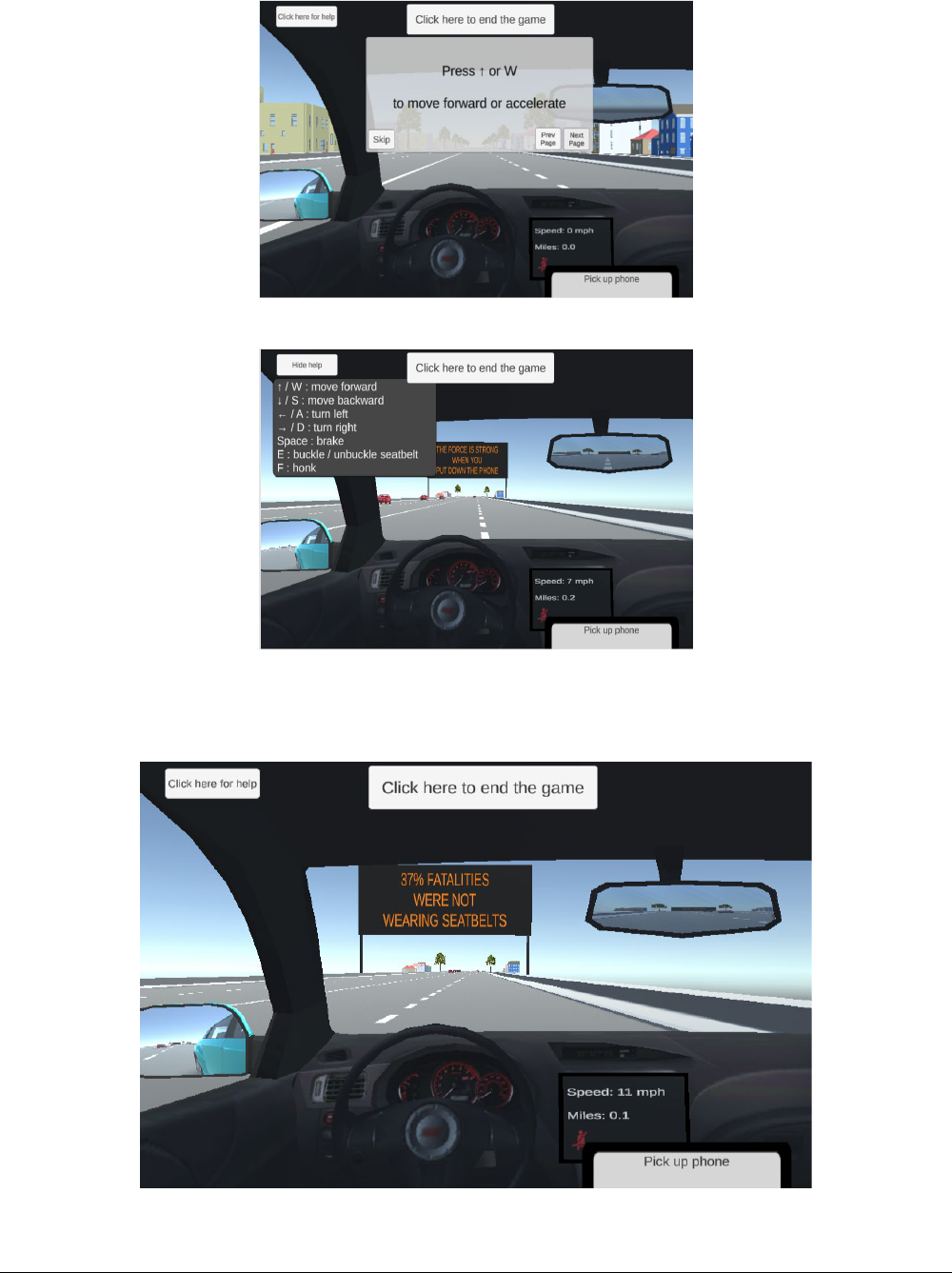
7
(a) Tutorial interface
(b) Driving interface
Figure 2. Screenshot. Basic GUI design for the online simulation game.
Figure 3. Screenshot. Nontraditional messages shown on a dynamic message sign.
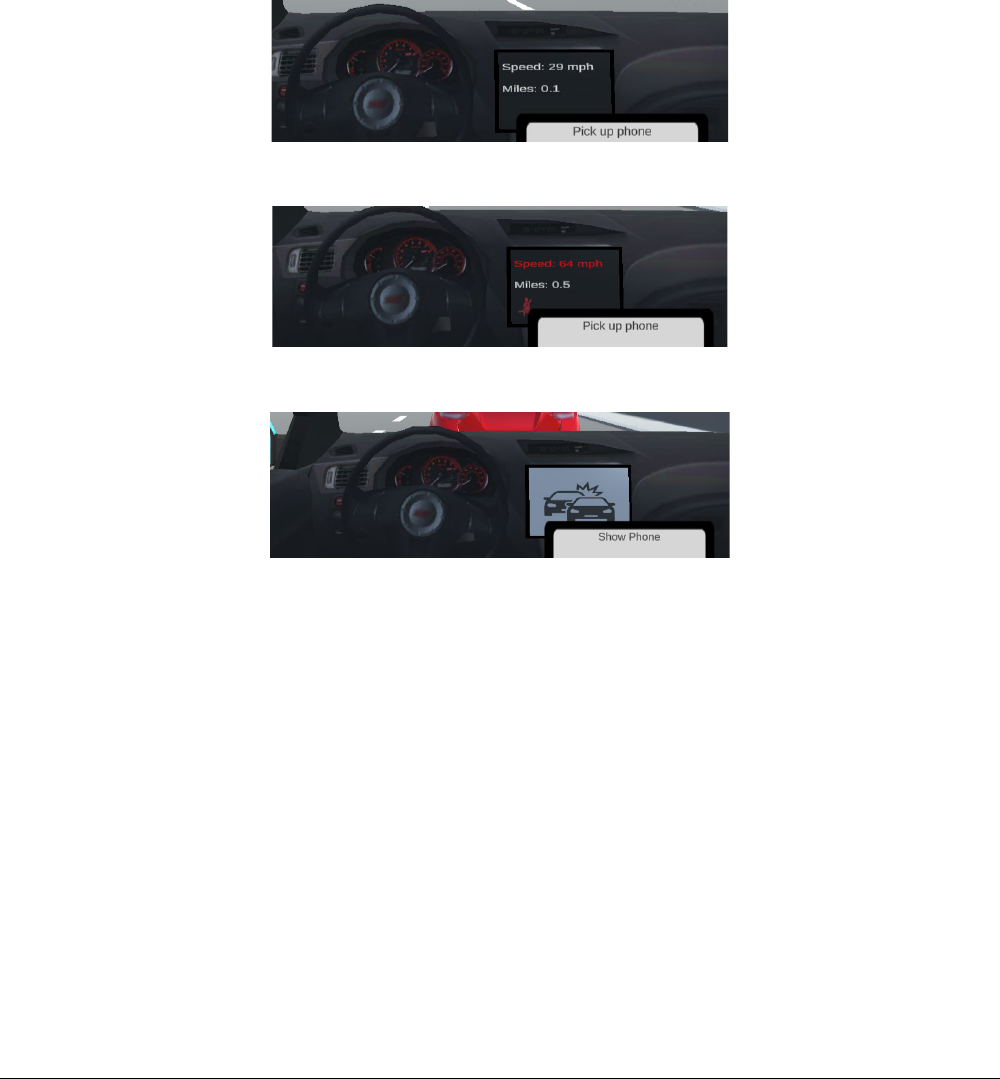
8
Participants also see a simple front panel that displays real-time driving status, including the current
speed, total distance traveled, seat belt use status, and crash status. The speed will display in white if
it is at or under the speed limit. It will turn red and blink three times if the participant is over the
speed limit. The same occurs for the seat belt status. The panel will display a red unbuckled logo if the
participant is not buckled up. Participants are unbuckled by default (at the beginning of the game),
and this is intended to test their seat belt use habit. Last, whenever a participant hits another car in
the simulation game, a crash logo will cover the whole panel and last for three seconds. Figure 4-a,
Figure 4-b, and Figure 4-c compare panels with and without these alarms.
(a) No alarm
(b) Speed alarm
(c) Crash alarm
Figure 4. Screenshot. Panels with and without alarms in the online simulation game.
Additionally, the simulation provides a simple phone interface, which allows participants to play
music, check emails/text messages, and answer calls. Participants can either show or hide the phone
interface at any time while driving. When the phone interface is activated, as shown in Figure 5-a, the
driver’s vision is partially blocked, mimicking real-world eyesight distractions. Figure 5-b shows five
possible phone interfaces at different stages of use. The first interface displays four possible
application icons, which indicates that the phone is not in active use. Users can access different
functionalities: music (upper left), texting (upper right), text messages (lower left), and phone calls
(lower right). If the participant clicks on the music icon, he or she can further choose one of three
types of music genres. If the participant clicks on the text messaging, email, or call icon, a
corresponding dialog box will pop up. In the simulation game, emails and phone call events are
automatically generated approximately every 40 and 80 seconds, respectively, to distract participants

9
and observe their behavior while distracted. Participants will hear alert sounds from the phone when
such an event occurs but can either ignore or respond to the pop-up messages or phone calls. Phone
call alerts automatically end after 10 seconds if participants do not interact with the phone interface.
(a) Activated phone interface
(b) Five possible interfaces for accessing music, texting, email, and phone calls
Figure 5. Screenshot. Phone interfaces in the simulation game.
Dynamic Messages
The main purpose of this game is to check which type(s) of dynamic messages are effective in
changing driver behavior for increased compliance and decreased crash activity. As such, over 80
nontraditional messages are gathered and sorted into 15 categories based on the literature review
(Shealy et al., 2020). Each nontraditional message is categorized by target behavior and emotion.
There are five target behaviors (general safe driving, driving without a seat belt, distracted driving,
impaired and drowsy driving, and general aggressive driving) and three emotions (emotionless,
humorous, and negative). Table 1 lists the different types of nontraditional dynamic messages, their
relative frequency of use in the simulation games, and some representative examples. Appendix A
presents the complete list of messages used in the game.

10
Table 1. Nontraditional Messages Grouped by Target Behavior and Emotion
Index
Behavior
Emotion
Frequency
of use (%)
Representative example
1
General safe
driving
Emotionless
7.12
DRIVING SAFELY?
I LIKE IT
I LOVE IT
2
General safe
driving
Humorous
4.66
SANTA’S COMING
HAVE YOU BEEN A GOOD DRIVER?
3
General safe
driving
Negative
6.01
757 FATALITIES SONS, DAUGHTERS
STOP THE HEARTACHE
4
Driving
without a seat
belt
Emotionless
5.52
SEE YOUR BFF TONIGHT
BUCKLE UP
5
Driving
without a seat
belt
Humorous
6.99
DUCK,
DUCK,
BUCKLE UP
6
Driving
without a seat
belt
Negative
6.87
72 WERE UNBUCKLED
7
Distracted
driving
Emotionless
5.64
PLAY BALL!
STRIKE THE
DISTRACTIONS
8
Distracted
driving
Humorous
11.53
AVOID AN APPSIDENT
PHONES DOWN
9
Distracted
driving
Negative
7.12
NO TEXT
IS WORTH
A LIFE
10
Impaired and
drowsy
driving
Emotionless
5.64
BE ALERT
ARRIVE UNHURT

11
Index
Behavior
Emotion
Frequency
of use (%)
Representative example
11
Impaired and
drowsy
driving
Humorous
6.38
DON’T BE TRICKED
DUIS ARE NO TREAT
12
Impaired and
drowsy
driving
Negative
7.12
BLOWING .08
IS LIKE
BLOWING $10,000
13
General
aggressive
driving
Emotionless
6.38
SPEEDING IS
UNSPORTSMANLIKE
CONDUCT
14
General
aggressive
driving
Humorous
4.91
IT’S OK
TO BE A
SLOW POKE
15
General
aggressive
driving
Negative
8.10
DO NOT TELL
A LIE
OBEY THE LIMIT
QUESTIONNAIRE
The purpose of the online questionnaire is to (i) investigate drivers’ demographic and socioeconomic
information, (ii) collect their opinion toward nontraditional dynamic messages, and (iii) accurately
capture the effectiveness of dynamic messages on impacting drivers’ behaviors. A total of 23
questions are presented to each participant via Google Forms. Among the 23 questions, one asks for
the ID used in the online simulation (to establish connection while remaining anonymous), four are
related to participants’ opinions toward nontraditional messages, eight are related to their
demographic and socioeconomic background, and 10 are related to their perception of driving
experience and acceptable driving behaviors. Neither personal information nor any forms of
identification were collected from the respondents. All questions and their corresponding intentions
are listed in Table 2.

12
Table 2. Online Questionnaire Questions and Corresponding Categories
Question #
Question
Intention
1
Please enter the same ID you used in the driving game.
Logistics
2
Among all the messages you saw today, which one(s) were the
most memorable and why?
Message Opinions
3
Do you think that any of the messages today were
inappropriate? If yes, which ones?
Message Opinions
4
Which type of behavior do you think those message(s) were
intended to address (select all that apply)?
Message Opinions
5
Given the following list of driving behavior, rank the
importance of changing the behavior: not wearing seat belts,
speeding, texting and driving, drinking and driving, and drowsy
driving. (1=lowest, 5=highest)
Message Opinions
6
What is your gender?
Demographic
7
What is your marital status?
Demographic
8
Which college are you in?
Demographic
9
Which of the following best describes your academic status?
Demographic
10
What type of area do you live in?
Socioeconomic
11
On which type of roads do you drive the most?
Socioeconomic
12
Do you own a car?
Socioeconomic
13
Have you been involved in accidents during the past 5 years?
Socioeconomic
14
How often do you listen to music or radio during driving?
Driving Behaviors
15
How often do you send text messages during driving?
Driving Behaviors
16
How often do you call others during driving?
Driving Behaviors
17
How often do you honk at others during driving?
Driving Behaviors
18
How often do you buckle up during driving?
Driving Behaviors

13
Question #
Question
Intention
19
How often do you change lanes frequently during driving?
Driving Behaviors
20
How often do you overtake if trapped behind a slow-moving
vehicle?
Driving Behaviors
21
If the speed limit is 25 mph, how fast do you consider as an
acceptable speed?
Driving Behaviors
22
If the speed limit is 55 mph, how fast do you consider as an
acceptable speed?
Driving Behaviors
23
If the speed limit is 70 mph, how fast do you consider as an
acceptable speed?
Driving Behaviors

14
CHAPTER 4: PILOT SURVEY RESULTS
A small-scale deployment of the game/survey was conducted on February 16–26, 2024. Both physical
and electronic flyers were distributed to 350 graduate students and 400 undergraduate students in
the Department of Civil and Environmental Engineering at the University of Illinois Urbana-
Champaign. A total of 118 responses were received by February 26, 2024, among which 80 finished at
least 3 miles of driving in the online simulation game, and 66 of them also completed the online
questionnaire. The remainder of this chapter summarizes the collected data.
ONLINE SIMULATION GAME RESULTS
The online simulation tracks each participant’s keyboard control records and the corresponding
vehicle movements every second and saves them for later statistical analysis. Recorded real-time
control data include, but are not limited to, (i) speed and location profiles; (ii) crash records, (iii)
participants’ seat belt status, (iv) participants’ reactions to phone messages and/or phone calls, (v)
participants’ lane changing controls, and (vi) participants’ honk actions. Table 3 and Figure 6-a to
Figure 6-f show an example of real-time recorded data from the same participant in the simulation
game. Table 3 lists all nontraditional messages seen by the participant as well as the corresponding
times at which they passed those signs. For example, at the 159th second, the participant saw the
message “DESIGNATED DRIVERS MAKE THE BEST NEW YEAR’S DATES,” which reminded the
participant to drive safely. Figure 6-a shows a participant’s driving speed record every second. This
participant obeyed the speed limit for the first half of the journey, while accelerating from 60 mph to
the maximum speed of 120 mph at about the 250th second. Figure 6-b shows the participant’s bird-
eye-view driving trajectory, where the x- and y-axis represent the longitudinal and lateral locations
with respect to the starting point. It also directly captures the participant’s lane changing actions. The
figure shows that this participant frequently changed lanes initially within the first mile, but then
drove stably in the remaining 3.2 miles of travel. Figure 6-c records the participant’s reaction to
incoming phone calls. Every time a text message pops up or a phone call comes (with audio and visual
prompts), a participant’s behavior toward these distractions is represented by his or her interactions
with the phone interface. This participant received phone calls at seconds 80, 160, 240, and 320, but
only picked up those at the 160th and 320th seconds. Figure 6-d and Figure 6-e show whether the
participant hit other cars or honked at other cars while driving, which is an important indicator of
aggressiveness. In both diagrams, honking and two crashes happened around the 320th and 330th
seconds. Recall that these crash times overlap with active phone usage near the 320th second, while
the vehicle is traveling at 120 mph, which indicates strong safety hazards imposed by phone use at
high speeds. Figure 6-f shows the participant’s seat belt buckled/unbuckled status while driving. The
participant started to buckle up only at the 260th second, soon after he or she saw two messages
related to seat belt usage: “60% OF TEEN ROAD DEATHS IN VIRGINIA ARE UNBUCKLED” and
“PROTECT YOURSELF BUCKLE UP,” which were displayed to him or her at the 235th and 249th
seconds. This observation indicates that dynamic messages do seem to have notable impacts on
drivers’ behavior on seat belt use.

15
Table 3. Sample Record of Shown Nontraditional Messages from One Simulation Game
Index
Time (sec)
Nontraditional messages
0
16th
BE ON SANTA'S
NICE LIST
DRIVE POLITELY
1
77th
YOU HAD ME AT
I DON’T TEXT AND DRIVE!
2
105th
DESIGNATED DRIVERS
MAKE THE BEST
NEW YEAR’S DATES
3
132nd
60% OF TEEN ROAD DEATHS
IN VIRGINIA
ARE UNBUCKLED
4
159th
9 OF 17 FATALITIES
UNBUCKLED THIS YEAR
5
186th
MOM NEEDS
YOUR HUG NOT
YOUR TEXT
6
214th
MOM NEEDS
YOUR HUG NOT
YOUR TEXT
7
235th
60% OF TEEN ROAD DEATHS
IN VIRGINIA
ARE UNBUCKLED
8
249th
PROTECT YOURSELF
BUCKLE UP
9
263rd
EDDIE SAYS
DON’T TEXT & DRIVE
THE TWITTERS FULL
10
277th
LIFE IS A HIGHWAY
DRIVE SAFELY ALL DAY LONG

16
Index
Time (sec)
Nontraditional messages
11
291st
TEXTING & DRIVING
IS CLEVER
SAID NO ONE EVER
12
305th
TEXTING WHILE DRIVING?
OH CELL NO.
(a) Speed profile
(b) Vehicle lateral location
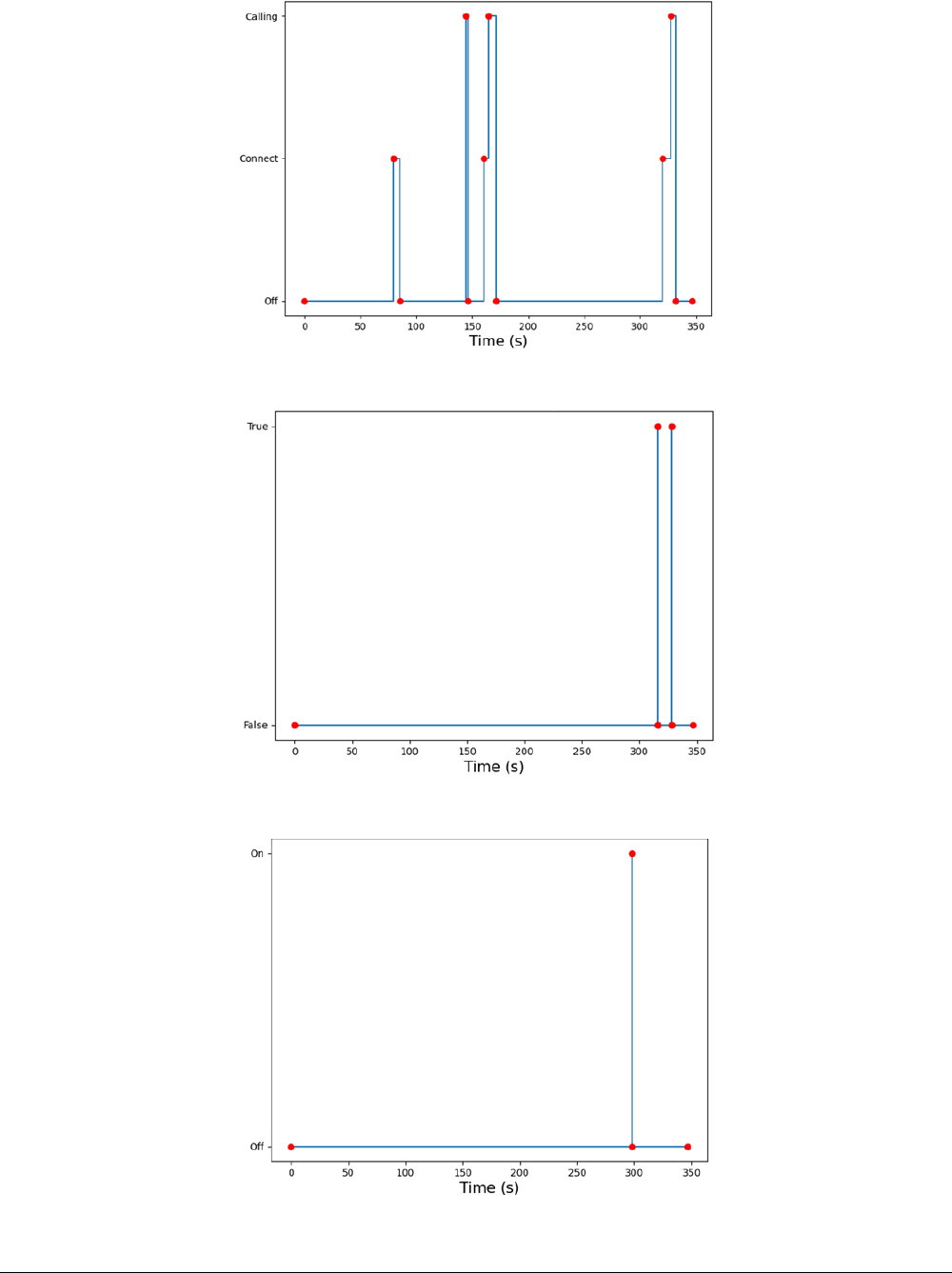
17
(c) Phone use status
(d) Crash status
(e) Honk actions

18
(f) Seat belt use status
Figure 6. Graph. Sample data records from the same participant.
All participants’ simulation data are sent to online cloud storage. In this way, an individual
participant’s data can be organized by attributes and merged with dynamic message data to enable
statistical behavior analysis. Figure 7-a to Figure 7-f are histograms of all collected participant data (a
total of 118 games, including those who did not drive more than 3 miles). Figure 7-a presents the
average speed histogram, which has a mode of 25–30 mph and an average of 43 mph. The speed
distribution is nearly normal, but there is a non-negligible portion of extreme speeds. Figure 7-b
shows the histogram of phone interactions. The phone interaction number has a mode of 0–2 times
and a mean of 11.8 times. Figure 7-c shows a histogram of the number of times participants honked
at other cars. Interestingly, only a few participants honked, but those who did, honked a lot—
indicating strongly opposite behavior among participants. The mode of the honking number is 0
times, and the mean is shockingly 20.2 times. Figure 7-d shows a histogram of the crash number.
Nearly half of the respondents experienced at least one crash. The mode of the crash number is 0
times, and the mean is 1.18 times. Figure 7-e presents a histogram of the time it takes participants to
buckle up their seat belts for the first time. Over 62% of participants who buckled up in the game (or
43 out of 74) buckled up their seat belts as they started to drive; 44 participants never buckled up
throughout the simulation game. Figure 7-f shows a histogram of the distance traveled by
participants. The mode of traveling distance is 3 miles and the mean is 3.43 miles. In summary, most
participants drove within the speed limit and rarely made aggressive actions, while, on the other
hand, we observed a small number of extremely aggressive behaviors as well.
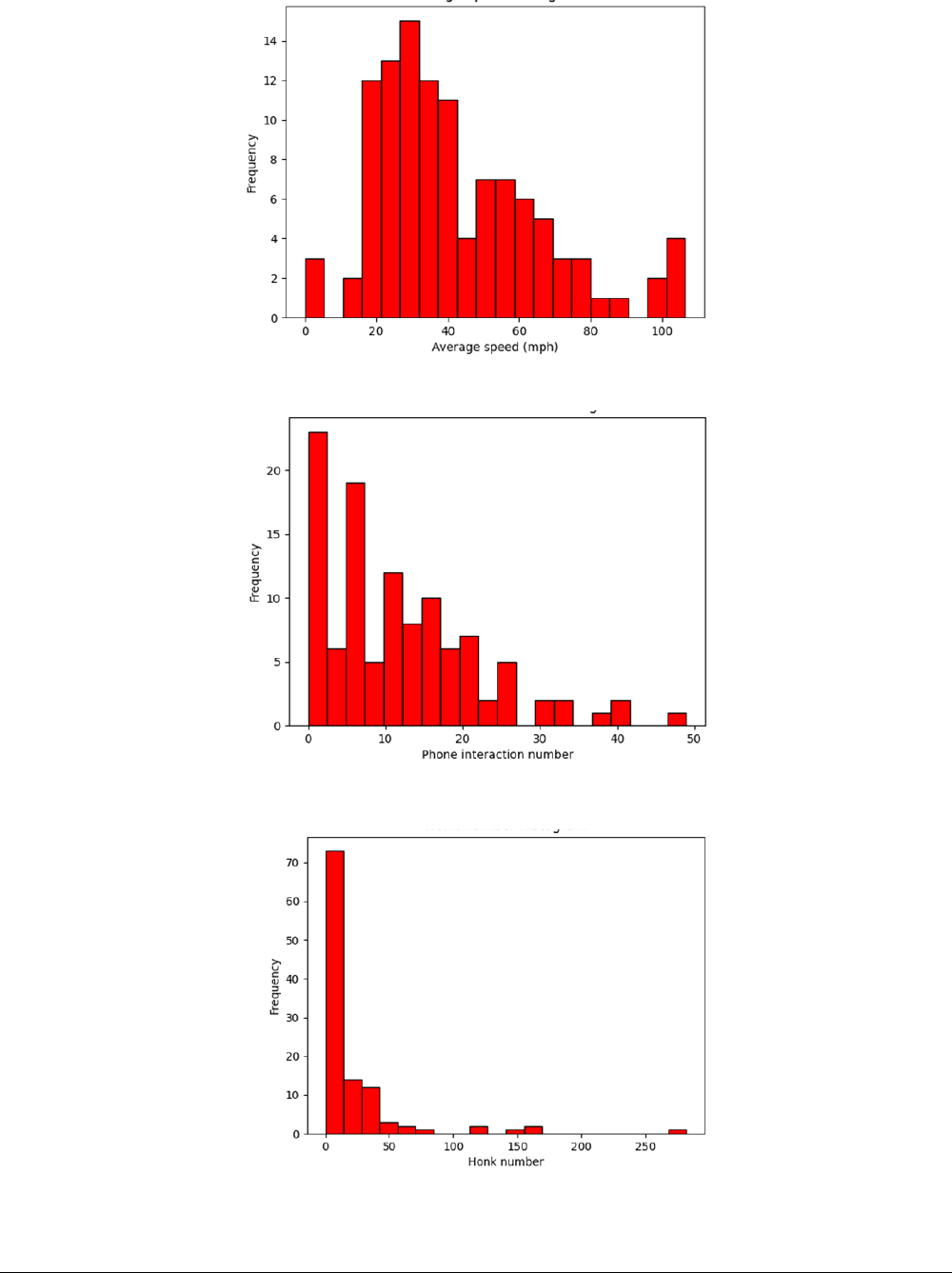
19
(a) Average speed
(b) Phone use number
(c) Honk number
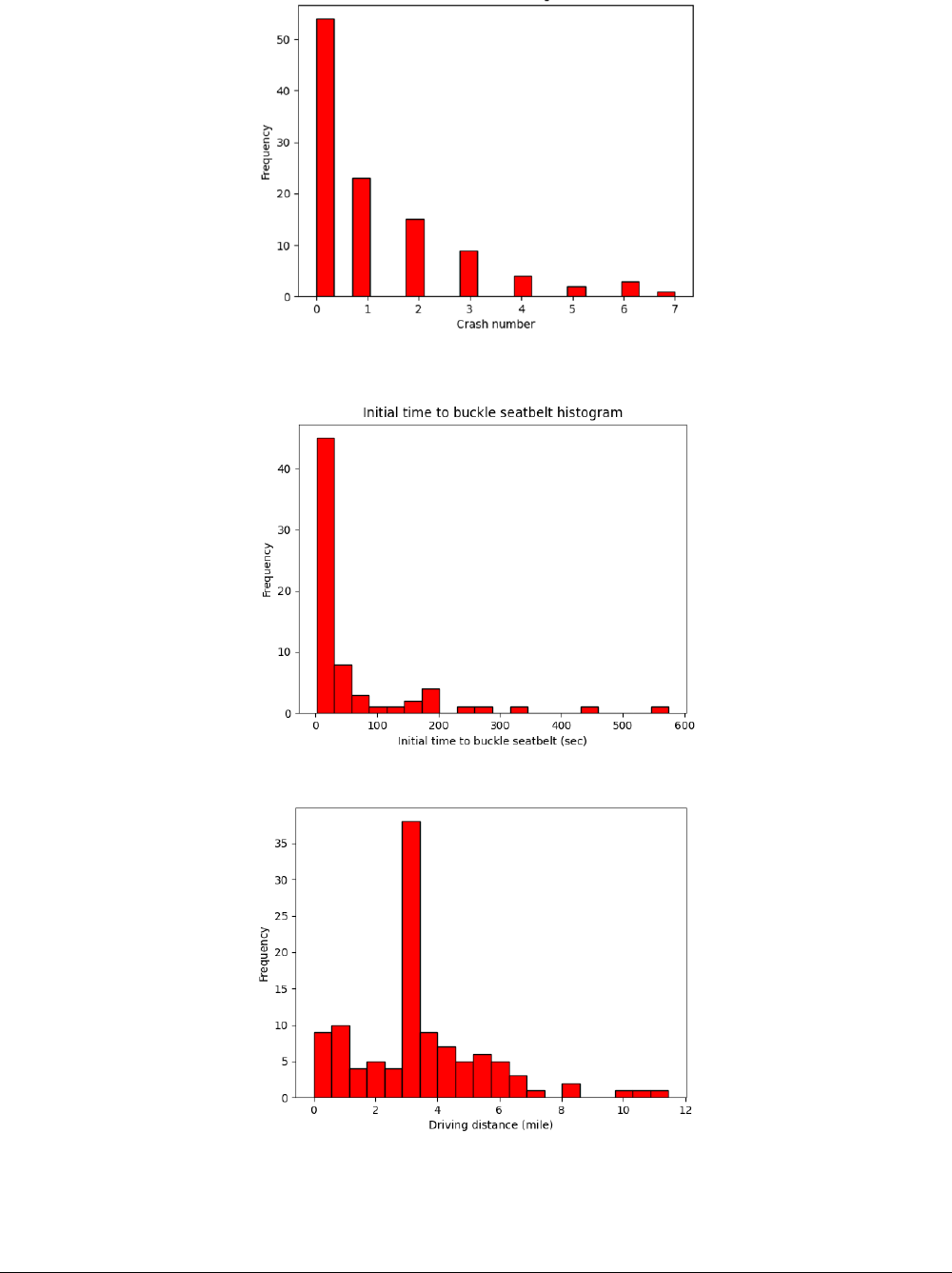
20
(d) Crash number
(e) Time to buckle seatbelt
(f) Travel distance
Figure 7. Graph. Histograms of attributes among 118 participants.
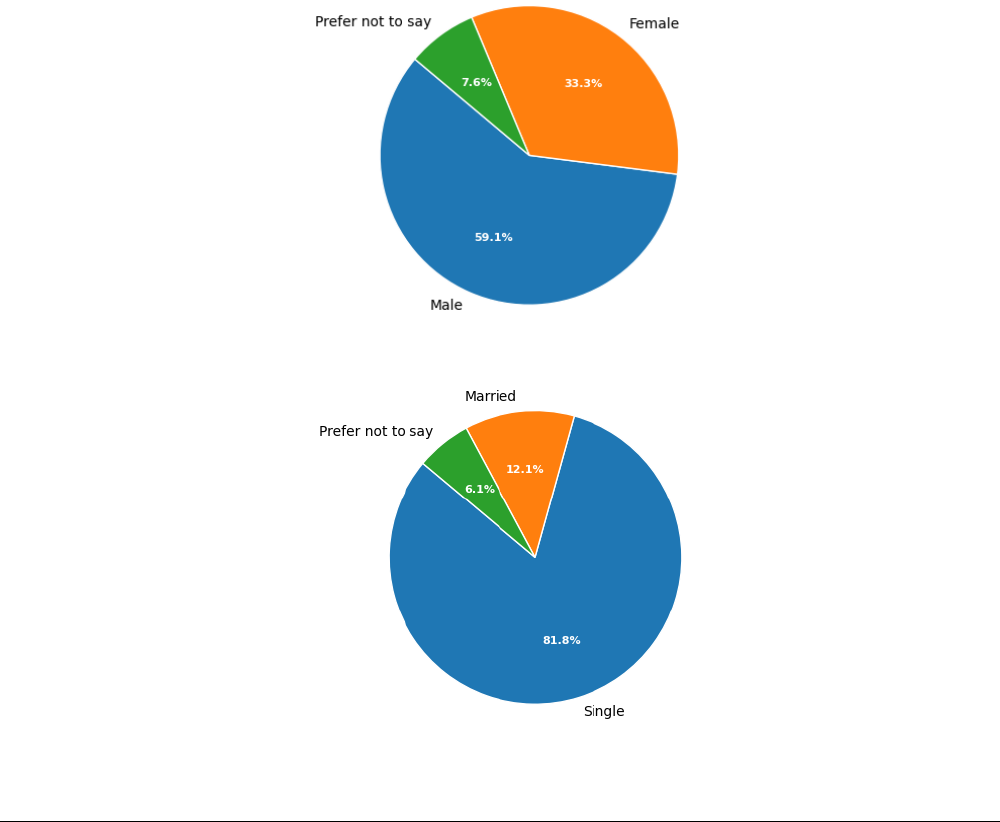
21
QUESTIONNAIRE DATA
A total of 66 valid responses were collected from the questionnaire, and they are classified into four
main categories: demographic information, socioeconomic information, driving experience and
behavior perception, and opinions toward nontraditional messages. Histograms and pie graphs are
plotted to show a clear view of these responses.
Demographic Information
Figure 8-a to Figure 8-d plot pie graphs of participants’ demographic information. Figure 8-a is the
gender pie graph, which shows that the whole surveyed group is composed of at least 59.1% males
and 33.3% females. These percentages largely match the demographic profile of students in UIUC’s
civil engineering department—indicating that males and females are largely equal in willingness to
participate in the game/survey. Figure 8-b shows the marital status, indicating that 81.8% of the
participants are single and 12.1% are married. Figure 8-c shows that most but not all (90%)
participants are from the engineering college—indicating some participants from other colleges were
invited by civil engineering students. Figure 8-d shows the distribution of their academic standing,
where an approximately equal share of respondents are undergraduate, master’s, and PhD students.
(a) Gender
(b) Marital status
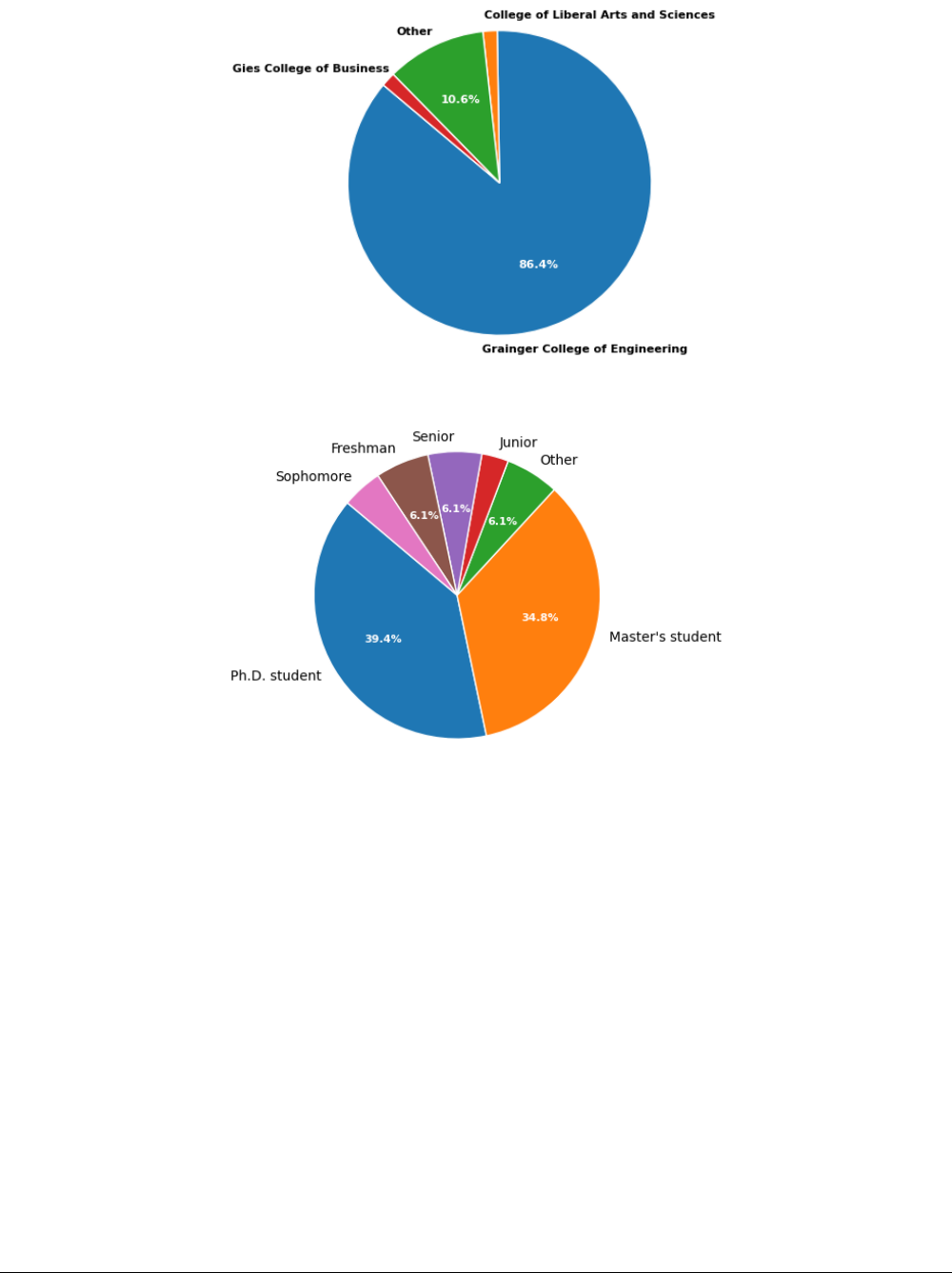
22
(c) College status
(d) Academic status
Figure 8. Graph. Demographic information of respondents.
Socioeconomic Information
Figure 9-a to Figure 9-d plot pie graphs of the participants’ socioeconomic information. Figure 9-a
shows the participants’ living area; nearly half of them live in suburban areas and half in urban areas.
Figure 9-b indicates the driving experience with roadway types. The most driven road type is
municipal streets (33.3%), and the least driven road type is interstate freeway (7.6%). Figure 9-c
shows that only half of the participants have a car and/or possess legal driving ability. Figure 9-d
presents responses to the question of whether an accident happened in the past 5 years, and 13.6%
participants responded “yes” to this question.

23
(a) Living area
(b) Most driven road type
(c) Car ownership
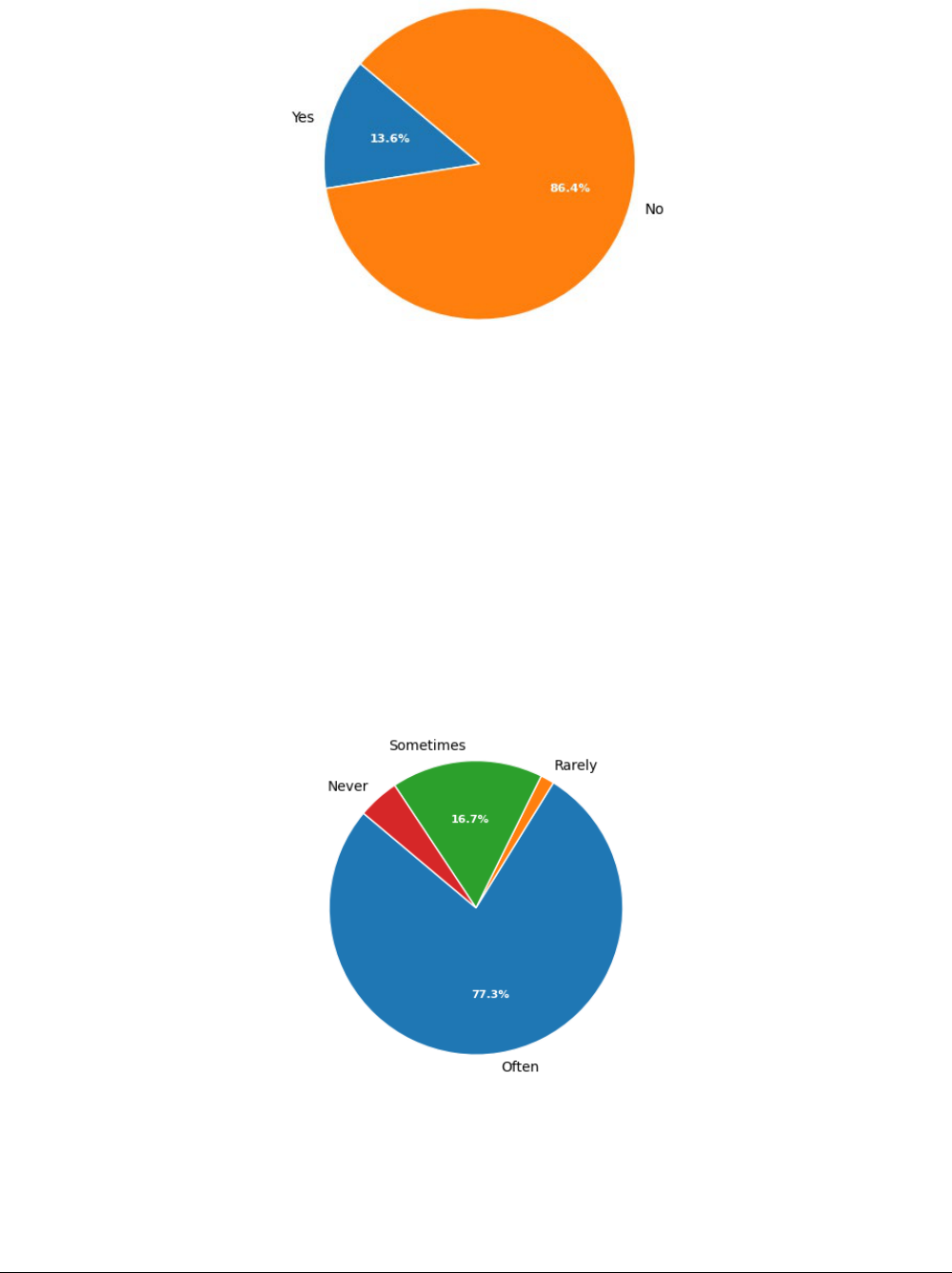
24
(d) Involved in an accident in past 5 years
Figure 9. Graph. Socioeconomic information of respondents.
Driving Behavior Information
Figure 10-a to Figure 10-d plot pie graphs of participants’ stated driving behavior. Each pie graph is
related to a typical behavior that may cause distracted driving. Figure 10-a shows that 77.3% of
participants often listen to music when driving. Figure 10-b shows that 36.4% of participants never
send text messages when driving, while at least 18.2% of them do sometimes or often send text
messages. Similarly for phone calls and honking, most participants responded “never” or “rarely” for
phone calling, but there was still a small portion (18.1% and 16.7%) that selected “sometimes” or
“often,” as shown in Figure 10-c and Figure 10-d, respectively. In general, when driving, most people
listen to music, rarely send text messages, rarely call others, and rarely honk at others.
(a) Listening to music
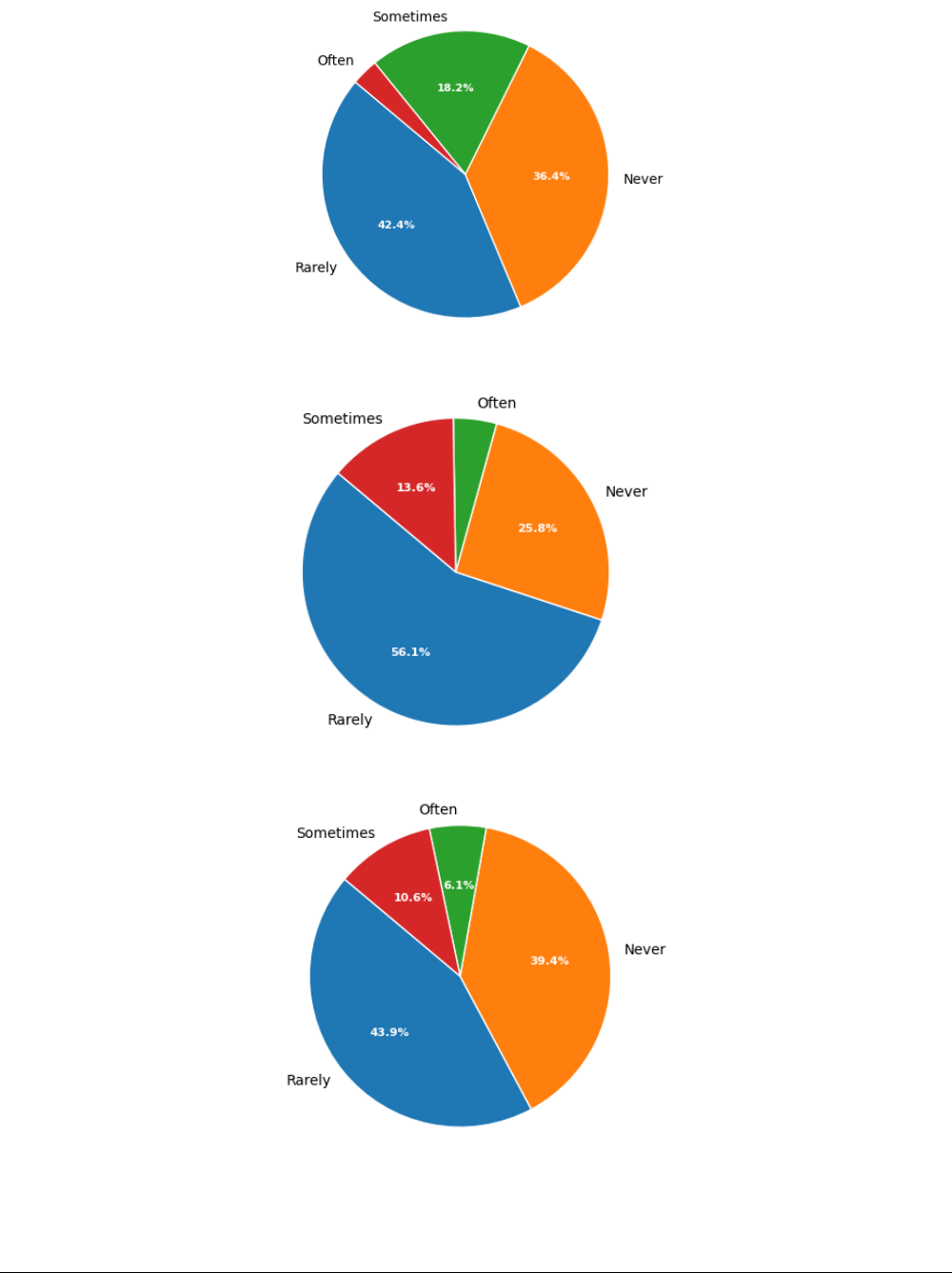
25
(b) Sending text messages
(c) Phone calling
(d) Honking at others
Figure 10. Graph. Driving behaviors information of respondents.
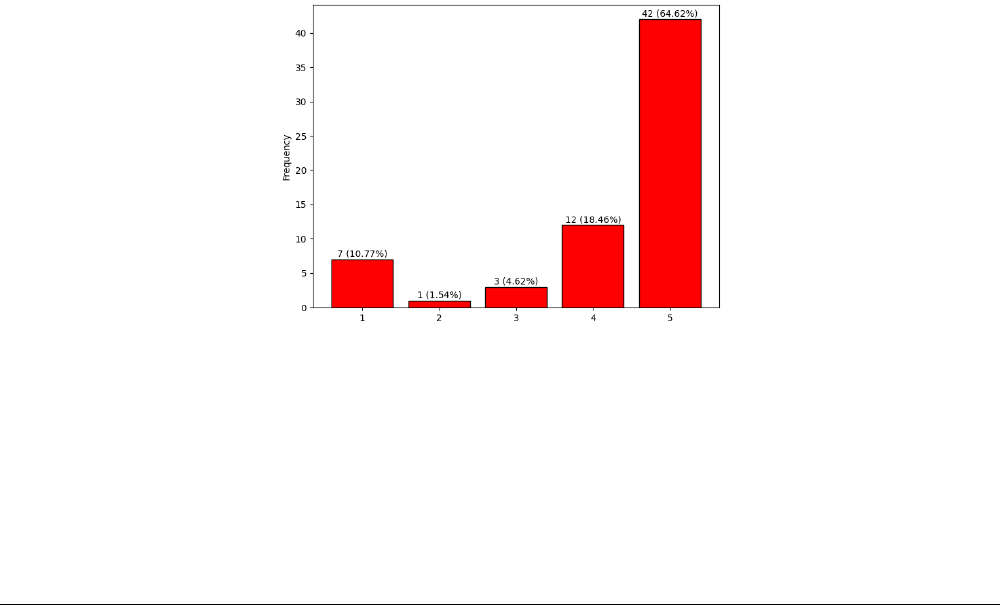
26
Impression on Nontraditional Messages
The questionnaire collected participants’ opinions toward nontraditional messages through ranking
the importance of different types of messages. The more people ranked a specific message higher,
the more important and more sensitive such a message is to the safe driving behavior of the public.
Figure 11-a to Figure 11-e show participants’ ranking of the importance of nontraditional messages
on changing a typical driving behavior. In sequence, Figure 11-a to Figure 11-e focus on messages’
importance to not wearing seat belts, speeding, texting and driving, drinking and driving, and drowsy
driving. We can compare the proportions of people ranking each target behavior as 1 (lowest) and 5
(highest). It is observed that 66.7% of participants rank speeding as 5, while 10.6% of participants
rank not wearing seat belts as 1. This indicates that most participants regard speeding as the most
important and dangerous behavior and not wearing seat belts as the least important and negligible
behavior.
Participants were also asked to recall the most memorable and inappropriate messages they saw
during the online simulation. Among the 66 questionnaire responses, 57 mentioned at least one most
memorable message and 47 responded at least one inappropriate message. Figure 12-a to Figure 12-
b present the composition of most memorable message types and inappropriate messages. Messages
related to seat belts (28%) and speeding (26%) are the two most memorable message types. Among
all responses to inappropriate messages, most people (76%) answered “no” recollection of such types
of messages. A few participants answered that those related to long dynamic messages and phone
calls were distracting for driving. Only 2% of participants gave specific messages that were considered
offensive, which suggested that including a specific culture as part of the message (e.g., “Luck of the
Irish won’t help if you drive drunk”) might not be appropriate. Some top responses to these two
questions are listed in Table 4.
(a) Not wearing seat belts
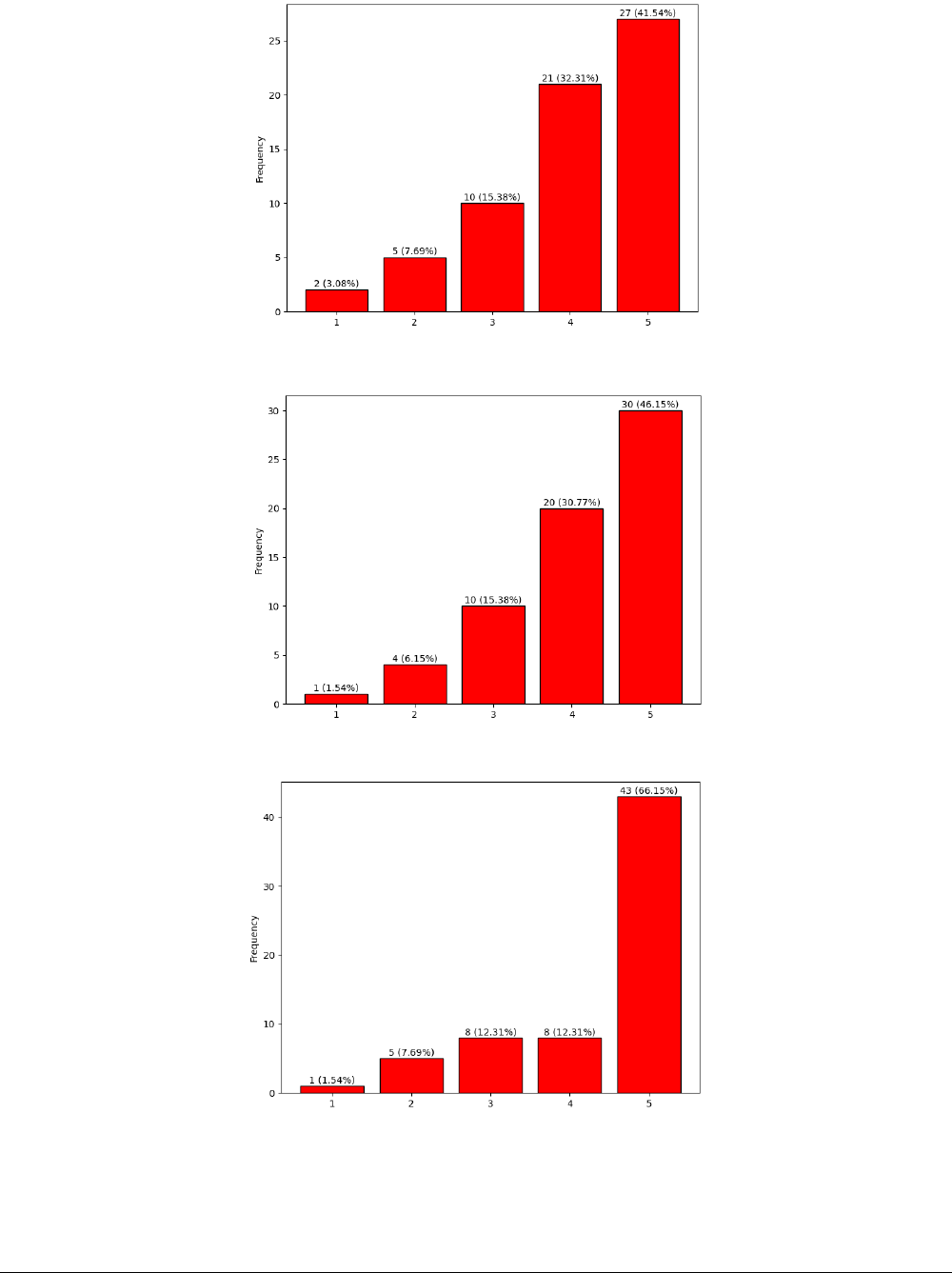
27
(b) Speeding
(c) Texting and driving
(d) Drinking and driving
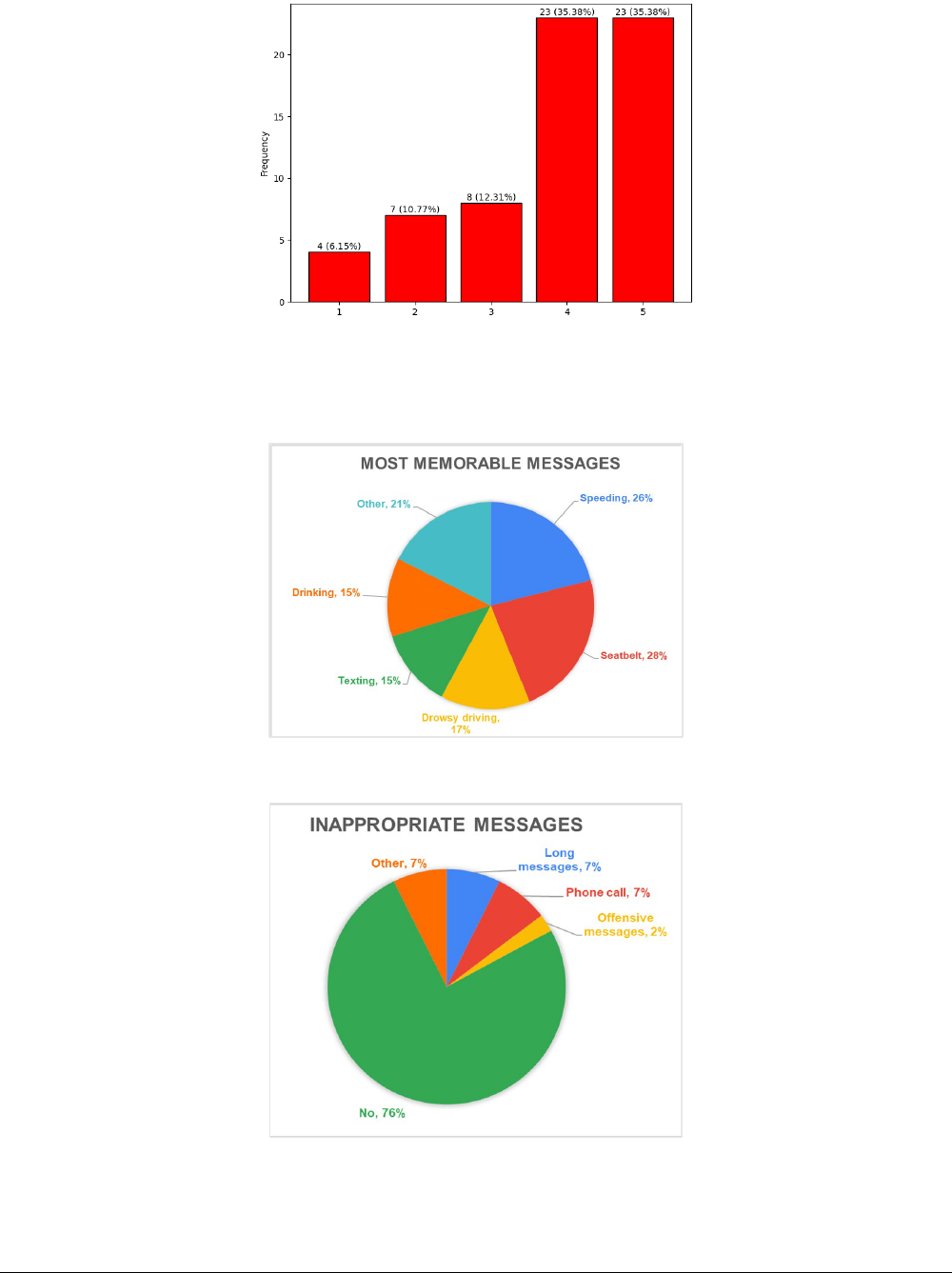
28
(e) Drowsy driving
Figure 11. Graph. Opinions toward nontraditional messages in the questionnaire.
(a) Most memorable messages
(b) Inappropriate messages
Figure 12. Graph. Most memorable and inappropriate messages.

29
Table 4. Sample Responses on Most Memorable and Inappropriate Messages
Top
response
Among all the messages you saw
today, which one(s) were the most
memorable and why?
Do you think that any of the messages
today were inappropriate? If yes, which
ones?
1
“Buckle up and smell the rose”
“We pity the fool who texts & drives”
2
“72 were unbuckled”
“Luck of the Irish won’t help if you drive
drunk”
3
“It’s the temperature not the speed
limit”
“I think those messages contain too many
words”
4
“It’s ok to be a slow poke”
“I think they were ok. I think any jokes or
puns that make it take longer to read or
longer messages are distracting. short
jokes/puns ok.”

30
CHAPTER 5: PRELIMINARY DATA ANALYSIS
As mentioned in Chapter 4, each participant’s simulation game experience generates a series of data
trajectories that record their real-time actions to dynamic message signs seen along the drive. In this
preliminary data analysis, we are interested in analyzing if, and how, different types of nontraditional
messages can help improve safety with regard to five types of safety practice: (i) reducing average
driving speed, (ii) discouraging speeding, (iii) reducing phone use while driving, (iv) reducing honking
actions, and (v) encouraging seat belt usage.
We assume for simplicity that all participants’ reactions to various messages are independent of each
other, and the participants are memoryless of past messages. Since an average participant sees a new
message sign almost every 20–40 seconds (every 0.5 mile, based on the driving speed), we choose to
capture the effects of a nontraditional message simply by the difference between the participants’
observed safety practices 10 seconds before and 10 seconds after passing that message sign. These
periods will be referred to as “before” and “after” respectively.
Figure 13 shows an example on how the effects of a message on reducing speed are measured
quantitatively. At the 277th second, a participant passed a sample message saying: “LIFE IS A
HIGHWAY DRIVE SAFELY ALL DAY LONG,” which belongs to category tag #1 in Table 1: “general safe
driving” and “emotionless.” The average speed in the before period of 267–277 seconds is 32 mph,
and that in the after period of 277–287 seconds is 22 mph. The difference of average speeds,
measured as the speed after passing the message minus the one before passing the message, is −10
mph. That particular message has a positive impact on reducing the average driving speed for this
particular observation. However, we must use statistics to draw more confident conclusions. To do
so, we make such measurements for each used dynamic message for each participant (grouped by
the category of the dynamic message target behavior and emotion) and conduct similar
measurements for each type of observed safety practice change. Then, we have 15 groups of
messages as well as five types of safety practice observations, and apply statistical analysis. All
participants’ reactions to three types of emotion messages in the target behavior category “general
safe driving” can be compared. For each of the five safety practice types, a two-sample t-test can be
applied between any two message groups to generate the -value and the -statistic. If the -value is
smaller than 0.05, then we are 95% confident that the two groups do not statistically have the
identical mean (or expected effect).
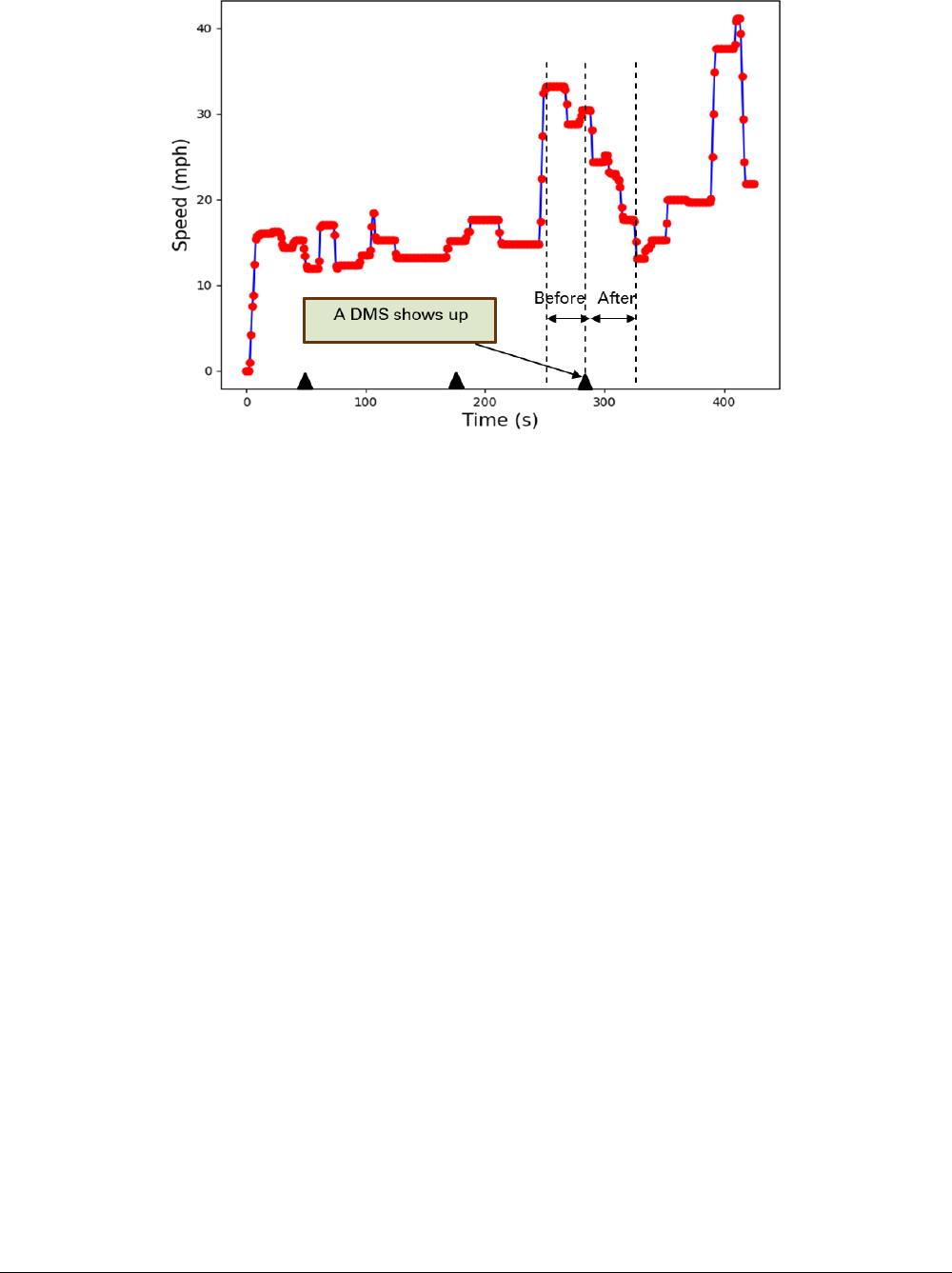
31
Figure 13. Graph. Quantitative analysis of speed reduction by message signs.
The remainder of this chapter will present preliminary analysis results on each of the five safety
practice types.
AVERAGE SPEED REDUCTION
Before-and-after data related to messages from categories 14–16 in Table 1 (“general aggressive
driving” + three types of emotions) are selected to analyze their impacts on average speed change.
For each observation, the average speed difference is computed as Equation 1:
=
−
(1)
where
and
represent the average speed in the after and before period, respectively. A
negative value of indicates a decrease in the average speed after seeing the sign.
Figure 14-a and Figure 14-b show the means and distributions of , respectively, for the three types
of emotion messages. Negative emotion messages decrease the average speed by 1.65 mph, whereas
emotionless messages decrease speed only marginally by 0.14 mph, and humorous messages have a
strong “negative” effect of increasing speed by 9.45 mph.
Two-sample t-tests are conducted to see if there are statistically significant differences among these
types of emotions. Table 5 reports the results. We find with 99% confidence that messages with a
negative emotion are significantly more effective than emotionless or humorous ones. This also
indicates strongly that humorous messages should probably be avoided if we would like to remind
drivers to reduce speed.
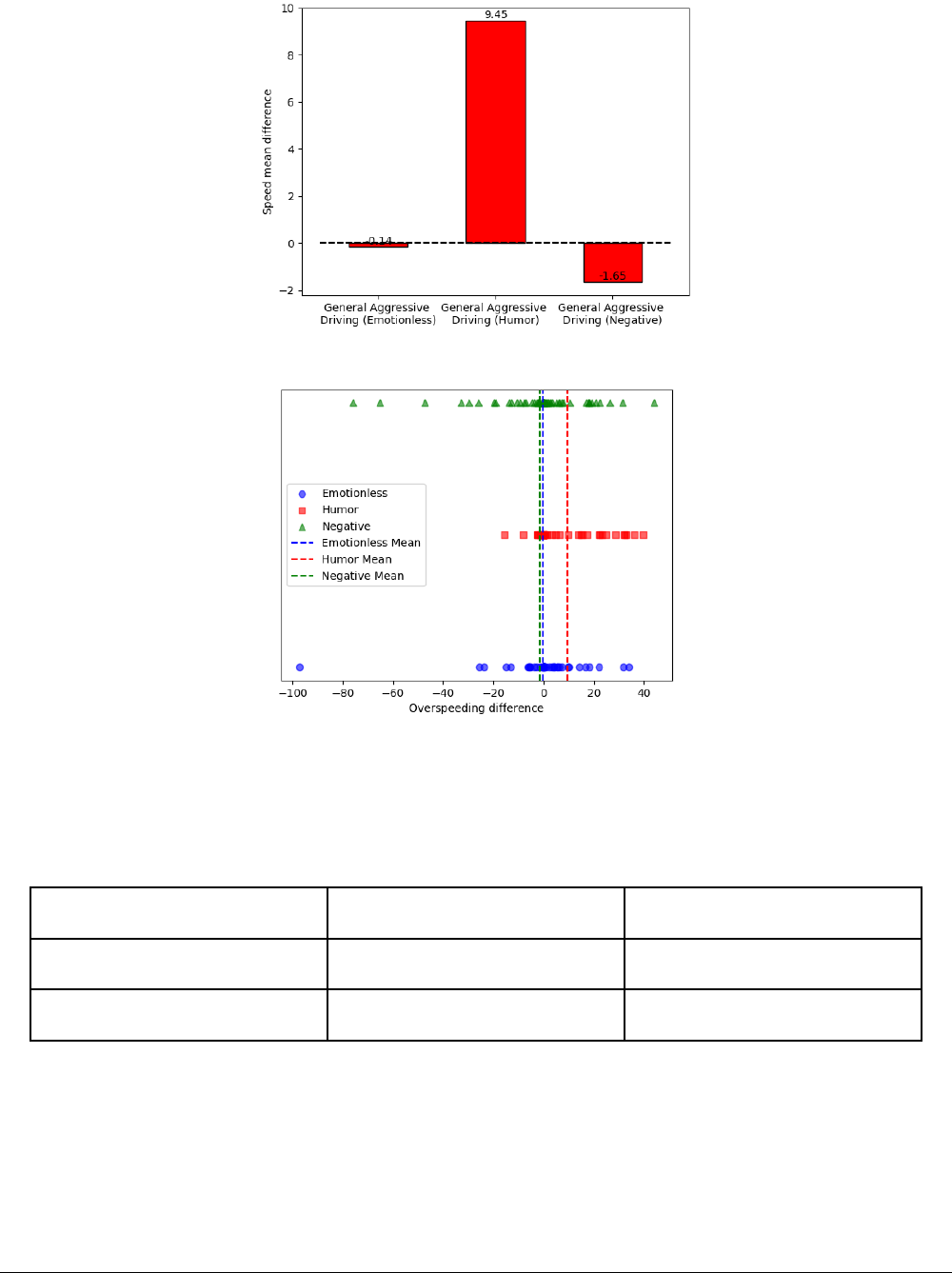
32
(a) Mean of
(b) Distribution of
Figure 14. Graph. Effectiveness of three emotions in general safe driving to reduce speed.
Table 5. Two-Sample t-test between Three Emotions in Reducing Speed
t-statistic
p-value
Humor vs Negative
−3.05
0.00
Humor vs Emotionless
−2.59
0.01
SPEEDING
Before-and-after data related to messages from categories 14–16 in Table 1 (“general aggressive
driving” + three types of emotions) are selected to analyze their influences on speeding. For each
observation, the speeding difference is computed as Equation 2:
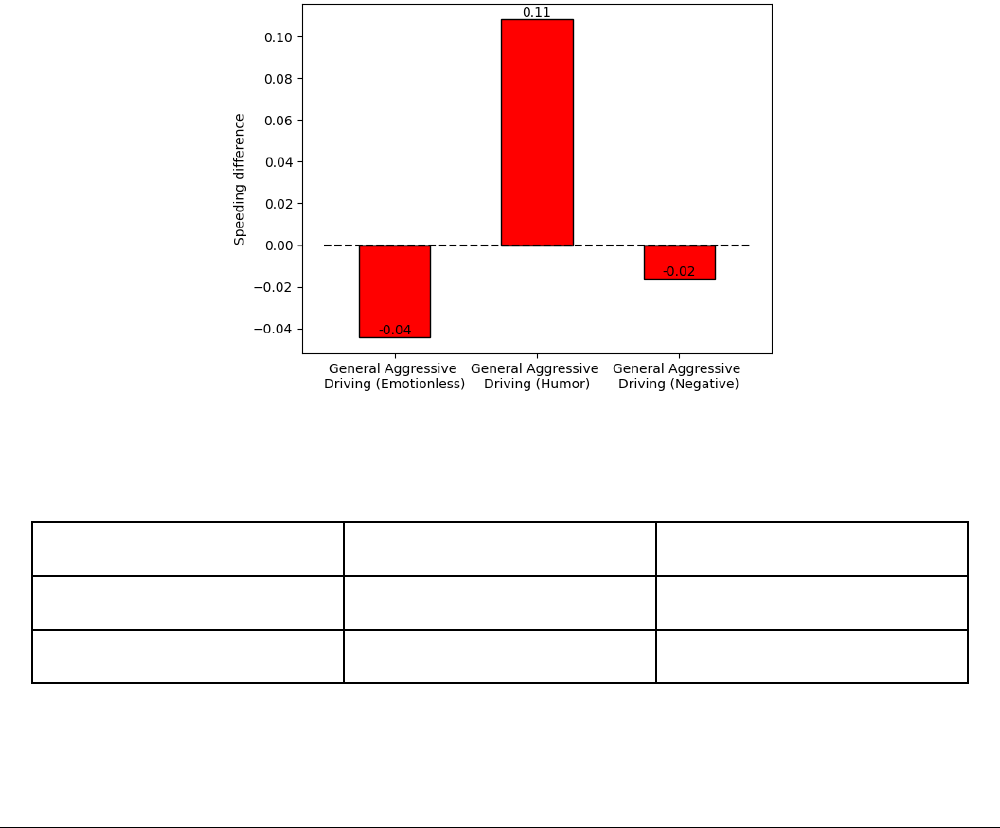
33
= 1(
≥ 60) − 1(
≥ 60) (2)
where 1(⋅) is a logical indicator function that equals 1 if the condition in the parentheses is true, or 0
otherwise;
and
represent the average speeds in the after and before period,
respectively. A negative value of indicates the participant stops speeding after passing the
message sign.
Figure 15 shows the mean of for three types of emotion messages. Emotionless messages can
reduce speeding by 4%, while negative messages reduce speeding by 2%, and humorous messages
have a counterproductive effect of increasing the chance of speeding by 11%.
Two-sample t-tests are conducted to measure the statistical difference among the three types of
emotions. Table 6 presents the results. We find with 97% confidence that emotionless messages are
more effective than humorous ones. Messages with a negative emotion also reduce speeding
compared with humorous ones, implying that humorous messages should be avoided in reminding
drivers about speeding. In general, this is consistent with findings on speed reduction—possibly
because humorous messages make drivers feel less serious about speed limits.
Figure 15. Graph. Effectiveness of three emotions to avoid speeding.
Table 6. Two-Sample t-test between Three Emotions to Avoid Speeding
t-statistic
p-value
Humor vs Negative
−1.81
0.07
Humor vs Emotionless
−2.25
0.03
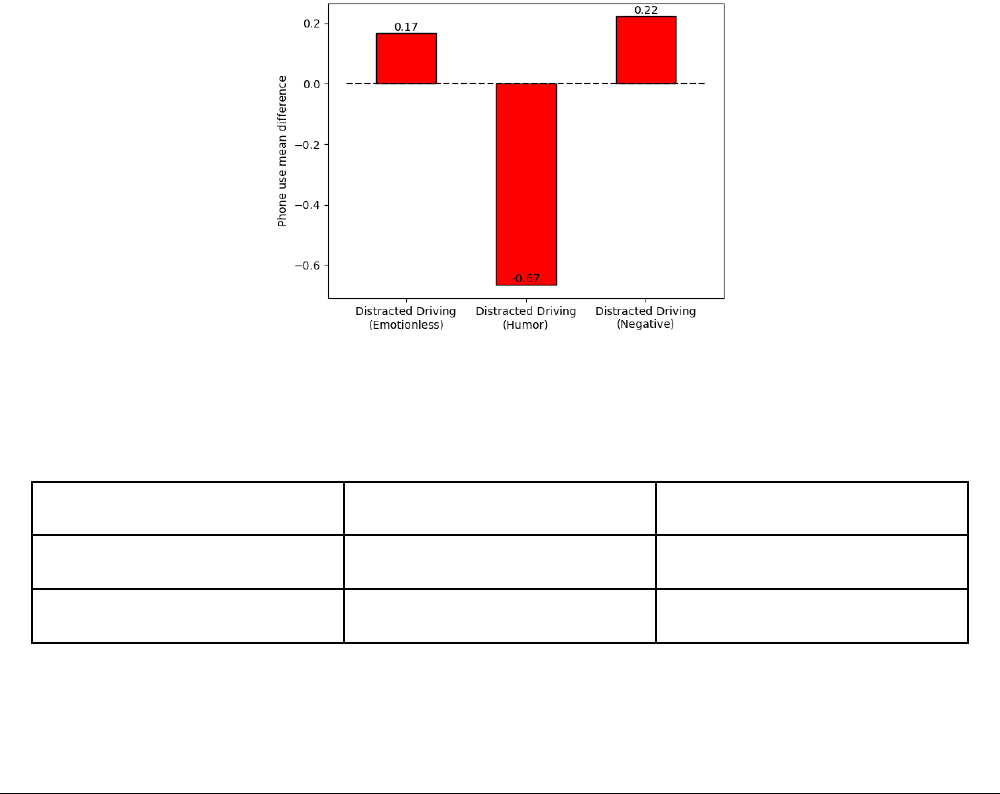
34
PHONE INTERACTIONS
Before-and-after data related to messages from categories 7–9 in Table 1 (distracted driving + three
emotions) under a high speed around 60–90 mph are selected to analyze their impacts on reducing
phone interactions. For each observation, the change in phone interaction number is computed as in
Equation 3:
=
−
(3)
where
and
represent the phone use number in the after and before period,
respectively. A negative represents the reduction of phone use after seeing a message sign. Figure
16 shows the mean of for three types of emotion messages. Humorous messages on distracted
driving can best reduce phone interactions by 0.67 times, while emotionless and negative messages
increase phone interactions by 0.17 and 0.22 times, respectively.
Two-sample t-tests are conducted to measure the statistical difference among the three emotions.
Table 7 presents the results. In particular, we find with 95% confidence that humorous messages are
more effective than emotionless ones. This implies that humorous messages could be effective in
reminding drivers to avoid phone use when they are driving at speeds between 60–90 mph.
Figure 16. Graph. Effectiveness of three emotions in distracted driving messages to reduce phone use.
Table 7. Two-Sample t-test between Three Emotions in Distracted Driving Messages to Reduce
Phone Use
t-statistic
p-value
Humor vs Negative
1.65
0.11
Humor vs Emotionless
2.16
0.05
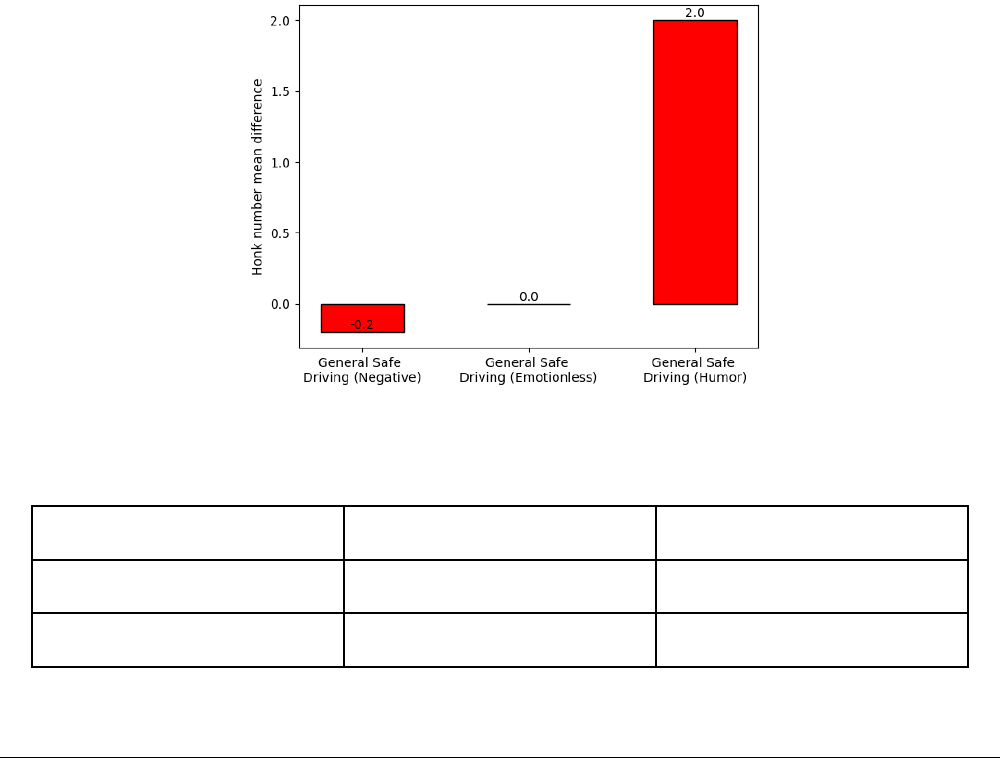
35
HONKING
Before-and-after data related to messages from categories 1–3 in Table 1 (general safe driving +
three types of emotions) when driving at speeds between 60–90 mph are selected to analyze their
effects on reducing honking. For each observation, the difference in honking number is computed as
Equation 4:
=
−
(4)
where
and
represent the number of honking actions in the after and before period,
respectively. A negative represents a reduction of honking after seeing a message sign.
Figure 17 shows the mean of for three types of emotion messages. Negative messages can reduce
honking by 0.2 times, and emotionless messages do not have notable impacts on the honking
number, while humorous messages have a counterproductive effect by increasing honking.
Two-sample t-tests are conducted to measure the statistical difference among three types of
message emotions. Results are shown in Table 8. We find that, with 98% confidence, negative
messages are more effective than humorous ones in reducing the frequency of honking. Humorous
messages probably should be avoided when the driving speed is around 60–90 mph.
Figure 17. Graph. Effectiveness of three emotions in general safe driving to reduce honking.
Table 8. Two-Sample t-test between Three Emotions in General Safe Driving to Reduce Honking
t-statistic
p-value
Humor vs Negative
−2.90
0.02
Humor vs Emotionless
−1.34
0.27
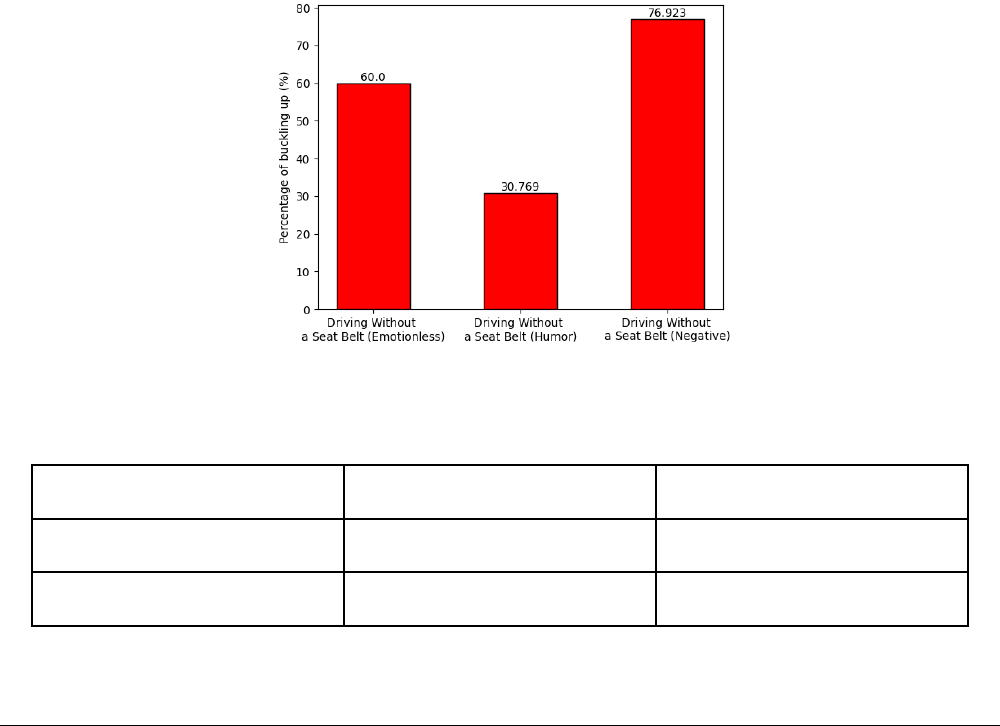
36
SEAT BELT USE
Before-and-after data related to messages from categories 4–6 in Table 1 (driving without seat belt +
three types of emotions) and having a speed lower than 60 mph are selected to measure the impacts
on seat belts. Note that only those not buckled in the before period are involved in this analysis. For
each observation, the change in seat belt status is computed as the effect of message signs in
Equation 5:
= 1(buckled after | unbuckled before) (5)
where 1(⋅) is the logical indicator function that equals 1 if the condition in the parentheses is true, or
0 otherwise. equals 1 if an unbuckled participant chooses to buckle up his or her seat belt after
seeing a message sign, or equals 0 otherwise. It can be interpreted as the conditional probability of
changing the buckling status. Figure 18 shows the mean of for three types of emotion messages.
For drivers previously not using a seat belt, negative messages can be most effective in reminding
about 77% to buckle up, emotionless messages can remind about 60%, and humorous messages are
least effective, only reminding 31% of participants to buckle up.
Table 9 shows the two-sample t-tests results. With 98% confidence, we conclude that negative
messages are more effective than humorous ones. This implies that negative messages could be most
effective in encouraging drivers to buckle up.
Figure 18. Graph. Effectiveness of three emotions in encouraging seat belt use.
Table 9. Two-Sample t-test among Three Emotions in Encouraging Seat Belt Use
t-statistic
p-value
Humor vs Negative
2.56
0.02
Humor vs Emotionless
0.85
0.41

37
ALTERNATIVE MESSAGE CATEGORIES
Please note that the categories of dynamic messages used in the previous sections are based on
those from the literature (i.e., Shealy et al., 2020). For some messages, especially for those under the
category of “emotionless,” their differences to “humorous” or “negative” can be subtle and highly
reliant on drivers’ interpretation and cultural background. For example, the message “DRIVING
SAFELY? I LIKE IT I LOVE IT” is classified as “emotionless” in Shealy et al. (2020); however, it also may
be considered “humorous” if one knows this is referring to the title of a song. Similarly, some of the
“emotionless” messages may be treated as “negative” due to individual drivers’ emotional mood or
perceptions. To test the robustness and accuracy of our statistical results, we conducted another
before-and-after analysis, using the same sample data and target driving behaviors, but with only two
message categories: humorous and negative. All messages in the emotionless category are
partitioned and re-grouped into the humorous and negative categories. Appendix C presents the new
list of messages by these two groups. Table 10 summarizes their relative frequency of use in the
simulation games, under the new categories.
Table 10. Nontraditional Messages Grouped by Target Behavior and Adjusted Emotion
Index
Behavior
Emotion
Frequency of use (%)
1
General safe driving
Humorous
13.70
2
General safe driving
Negative
3.80
3
Driving without a seat belt
Humorous
13.57
4
Driving without a seat belt
Negative
5.97
5
Distracted driving
Humorous
17.23
6
Distracted driving
Negative
7.19
7
Impaired and drowsy driving
Humorous
11.80
8
Impaired and drowsy driving
Negative
7.19
9
General aggressive driving
Humorous
11.13
10
General aggressive driving
Negative
8.42
Table 11 summarizes the two-sample t-tests results for five target safe driving behaviors with the
new message categories in specific driving speed ranges. With 96.6% confidence, we conclude that
the negative messages are more effective than humorous ones in encouraging speed reduction for
those driving slower than 60 mph. With 98% confidence, we conclude that negative messages are
more effective than humorous ones in avoiding speeding. With 96.5% confidence, we conclude that

38
humorous messages are more effective than negative ones in avoiding phone use when drivers are
driving at 60–120 mph. With 96.8% confidence, we conclude that negative messages are more
effective than humorous ones in encouraging seatbelt use when drivers are driving at 40–120 mph.
These results are generally consistent with those found in the previous subsections. The only
exception is about reducing honking, where no statistically significant difference is found.
Table 11. Two-Sample t-test among Emotions with New Categorization
Safety Behavior
/ Practice
Message
Category
Speed Range
(mph)
Mean
(Humorous)
Mean
(Negative)
t-statistic p-value
Average speed
reduction
(9) (10) 0–60 4.26 −2.17 2.18 0.034
Speeding (9) (10) 0–120 0.11 −0.03 2.37 0.019
Phone
interaction
(5) (6) 60–120 −0.46 0.2 −2.16 0.035
Honking – – – – – –
Seatbelt use (1) (2) 40–120 0.37 0.0 2.24 0.032

39
CHAPTER 6: CONCLUSION
This project completed three main tasks. First, a literature review was conducted to investigate past
studies researching driver behaviors and different types of dynamic message signs as well as to
explore similar projects experimenting on the effect of drivers’ behavior change caused by dynamic
message signs. Second, a web-based questionnaire and simulation were developed to capture
drivers’ opinions and behaviors toward dynamic message signs in a semi-realistic environment. Third,
a preliminary data analysis was conducted to develop a better understanding of how dynamic
message signs influence driver behaviors and to provide suggestions how IDOT may systematically
present information on dynamic message signs in practice. Some of the key findings are listed below:
• Avoid humorous messages when encouraging drivers to decrease speed.
• Use emotionless messages to discourage drivers from speeding.
• Use humorous messages when encouraging drivers to reduce frequency of texting and calling
when driving speed is 60–90 mph.
• Avoid humorous messages when discouraging drivers from honking at another driver when
driving speed is 60–90 mph.
• Negative messages are recommended in encouraging drivers to buckle up when driving speed
is lower than 60 mph.
The proposed online driving game and survey are able to protect the privacy of respondents and are
sufficiently robust for future extensions and adaptations to a more complex environment, such as
lighting conditions, weather conditions, road geometry, or traffic congestion. Additionally, any type of
nontraditional messages can be easily loaded and tested in the driving game. It is also possible to
investigate nontraditional messages’ effectiveness using a more sophisticated model, such as
trajectory data mining and deep learning, rather than making simplified assumptions and using
traditional statistical tests. The online driving game is expected to handle larger-scale experiments
and provide more comprehensive and valuable information in the future.
This study produces a synthesis of the available literature and preliminary data analysis of the driver
survey/experiment, and the findings provide recommendations for IDOT on the most effective
messages for Illinois. The result illustrates what type of message (emotionless, negative, humorous)
changes driver behavior for increased compliance and decreased crash activity. This project also
generates findings that will serve as guidance on when and where different kinds of messages may be
most effective, providing a long-term benefit to IDOT and partner agencies.

40
REFERENCES
Boyle, L., Cordahi, G., Grabenstein, K., Madi, M., Miller, E., & Silberman, P. (2014). Effectiveness of
safety and public service announcement (PSA) messages on dynamic message signs (DMS) (Report
No FHWA-HOP-14-015). Federal Highway Administration.
Francis, J. (2018). Unusual highway signs grab drivers’ attention. News Channel 20, November 29.
https://newschannel20.com/news/local/unusual-highway-signs-grab-drivers-attention.
Haghani, A., Hamedi, M., Fish, R., & Norouzi, A. (2013). Evaluation of dynamic message signs and their
potential impact on traffic flow (Report No. MD-13-SP109B4C). Maryland State Highway
Administration.
Harder, K. A., & Bloomfield, J. R. (2008). The effectiveness and safety of traffic and non-traffic related
messages presented on changeable message signs—Phase II (Report No. Mn/DOT 2008-27).
Minnesota Department of Transportation.
Huang, Y., Strawderman, L., & Garrison, T. (2013). Dynamic Message Signs, Driver Characteristics, and
Speed Reduction. IIE Annual Conference. Proceedings
Rodier, C. J., Lidicker, J. R., Finson, R. S., & Shaheen, S. A. (2010). An evaluation of the consequences
and effectiveness of using highway changeable message signs for safety campaigns (Report No.
CA10-1124). University of California PATH. https://trid.trb.org/view/919831
Schroeder, J., Plapper, E., Zeng, H., & Krile, B. (2016). Public perception of safety messages and public
service announcements on dynamic message signs in rural areas (Report No. FHWA-HOP-16-048).
U.S. Department of Transportation. Federal Highway Administration.
Shealy, T., Kryschtal, P., Franczek, K., & Katz, B. J. (2020). Driver response to dynamic message sign
safety campaign messages (Report No. FHWA/VTRC 20-R16). Virginia Transportation Research
Council. http://www.virginiadot.org/vtrc/main/online_reports/pdf/20-r16.pdf
Shroeder, J., & Demetsky, M. (2010). Evaluation of driver reactions for effective use of dynamic
message signs in Richmond, Virginia (Report No. FHWA/VTRC 10-R16). Virginia Transportation
Research Council.
Song, M., Wang, J., Cheung, Sam., & Keceli, M. (2016). Assessing and mitigating the impacts of
dynamic message signs on highway traffic. International Journal for Traffic and Transportation
Engineering, 6(1), 1–12.
Strawderman, L., Huang, Y., & Garrison, T. (2013) The effect of design and placement of work-zone
warning signs on driver speed compliance: A simulator-based study. IIE Transactions on
Occupational Ergonomics and Human Factors, 1(1), 66–75.
https://doi.org/10.1080/21577323.2012.714839

41
APPENDIX A: NONTRADITIONAL MESSAGES
Table 12. List of Nontraditional Messages Used in the Simulation Game
Behavior
Emotion
Messages
General safe
driving
Emotionless
NOBODY PUTS BABY IN A HOT CAR
DON’T YOU FORGET ABOUT ME AS YOU DRIVE ON BY
LIFE IS A HIGHWAY DRIVE SAFELY ALL DAY LONG
BE OUR GUEST DRIVE POLITELY
DRIVING SAFELY? I LIKE IT I LOVE IT
Humor
BE ON SANTA'S NICE LIST DRIVE POLITELY
WHAT'S SCARIER YOUR COSTUME OR YOUR DRIVING?
BE A FIREWORK SPARK RESPONSIBLE DRIVING
ZERO FATALITIES A GHOUL WE CAN ALL LIVE WITH
SANTA'S COMING HAVE YOU BEEN A GOOD DRIVER?
Negative
843 VA FATALITIES THIS YEAR DRIVE SAFELY
375 MILLION US VEHICLE INJURIES IN 2017
843 TRAFFIC DEATHS IN VIRGINIA THIS YEAR DRIVE ALERT
757 FATALITIES SONS, DAUGHTERS. STOP THE HEARTACHE
843 FATALITIES ON VIRGINIA ROADS IN 2018
Driving
without a
seatbelt
Emotionless
PROTECT YOURSELF BUCKLE UP
SECURE THE FUTURE BUCKLE YOUR CHILD
DON’T LEAP FROM YOUR SEAT BUCKLE UP
SEE YOUR BFF TONIGHT BUCKLE UP
BUCKLE UP SAVE $25 AND YOUR LIFE
Humor
DON’T MAKE ME STOP THIS CAR! BUCKLE UP

42
Behavior
Emotion
Messages
DUCK, DUCK, BUCKLE UP
AWWWWW SNAP! YOUR SEAT BELT!
BUCKLE UP AND SMELL THE ROSES
PEACE LOVE SEATBELTS BUCKLE UP!
Negative
72 WERE UNBUCKLED
9 OF 17 FATALITIES UNBUCKLED THIS YEAR
153 ROAD DEATHS IN VA THIS YEAR 66% UNBUCKLED
37% FATALITIES WERE NOT WEARING SEATBELTS
60% OF TEEN ROAD DEATHS IN VIRGINIA ARE UNBUCKLED
Distracted
driving
Emotionless
GOLD MEDAL DRIVERS DON’T TEXT AND DRIVE
MAKE IT TO THE END ZONE DRIVE ALERT
DON’T LET SAFETY BE A HAIL MARY DRIVE ALERT
PLAY BALL! STRIKE THE DISTRACTIONS
BLOW THE WHISTLE ON DISTRACTED DRIVING
Humor
GET YOUR HEAD OUT OF YOUR APPS
TEXTING WHILE DRIVING? OH CELL NO.
DON’T DRIVE IN-TEXT-ICATED
AVOID AN APPSIDENT PHONES DOWN
TEXTING & DRIVING IS CLEVER SAID NO ONE EVER
WHO YA GONNA CALL? NOBODY YOU’RE DRIVING
YOU HAD ME AT “I DON’T TEXT AND DRIVE!"
THE FORCE IS STRONG WHEN YOU PUT DOWN THE PHONE
EDDIE SAYS DON’T TEXT & DRIVE THE TWITTERS FULL

43
Behavior
Emotion
Messages
WE PITY THE FOOL WHO TEXTS & DRIVES
Negative
NO TEXT IS WORTH A LIFE
MOM NEEDS YOUR HUG NOT YOUR TEXT
YOUR PHONE OR YOUR LIFE? YOUR CHOICE
ONE TEXT CAN END IT ALL
IS YOUR TEXT WORTH
THE RISK?
Impaired and
drowsy
driving
Emotionless
DON’T SNOOZE WHILE YOU CRUISE
BE ALERT ARRIVE UNHURT
DROWSY DRIVING IS LOUSY DRIVING
WE’VE GOT A FEVER THE ONLY CURE IS SOBER DRIVERS
DRINKING AND DRIVING DON’T MIX
Humor
YOU’RE NOT A FIREWORK DON’T DRIVE LIT
LUCK OF THE IRISH WON’T HELP IF YOU DRIVE DRUNK
A DUI WILL EMPTY THE POT O GOLD DRIVE SOBER
DESIGNATED DRIVERS MAKE THE BEST NEW YEAR’S DATES
DON’T BE TRICKED DUIS ARE NO TREAT
Negative
BLOWING .08 IS LIKE BLOWING $10,000
JUST BUZZED? NICE TRY, THAT’S A DUI
DRIVE HAMMERED GET NAILED
DON’T LET YOUR TAILGATE END WITH A CELLMATE
DRINKING AND DRIVING A GRAVE MISTAKE
Emotionless
SPEEDING IS UNSPORTSMANLIKE CONDUCT

44
Behavior
Emotion
Messages
General
aggressive
driving
MARCH MADNESS? KEEP AGGRESSION ON THE COURT
NO SHOT CLOCK DRIVING A CAR SLOW DOWN
KEEP RIVALRIES OFF THE ROAD DRIVE CALM
COMMUTING ISN’T A COMPETITIVE SPORT RELAX
Humor
I THINK WE NEED SOME SPACE ONE DRIVER TO ANOTHER
IT’S OK TO BE A SLOW POKE
IT’S A SPEED LIMIT NOT SPEED SUGGESTION
SPEEDING CAN LEAD TO SKID MARKS
THAT’S THE TEMPERATURE NOT THE SPEED LIMIT
Negative
DO NOT TELL A LIE OBEY THE LIMIT
SPEED KILLS SLOW DOWN
KEEP YOUR DISTANCE SAVE A LIFE
LEAVE SOME SPACE SURVIVE THE DRIVE
DON’T BE NEXT KEEP YOUR DISTANCE

45
APPENDIX B: CONSENT DOCUMENT FOR THE GAME/SURVEY
Principal Investigator Name and Title: Yanfeng Ouyang, Professor
Department and Institution: Civil and Environmental Engineering, Illinois Center for Transportation
Contact Information: Tel: 217-333-9858, E-mail: [email protected]
Sponsor: Illinois Department of Transportation (IDOT)
The consent is being sought for research, and participations are voluntary. The purpose of this project is to
determine: (i) if non-standard driver messages cause a change in driver behavior and reduce crash frequency in
the freeway area of the signage inside Illinois, (ii) if the messages increase engagement of the motoring public
with safer driving practices, and (iii) if the messages have a lasting impact (does the message stick) on drivers
who see the messages. You will be asked to complete one 10-min online survey form and one 5-min online
driving simulation. No identifiable information is collected, and all reactions are anonymous throughout the
study. You will not directly benefit from the result of this study.
BACKGROUND
You are being asked to take part in a short online survey, which is conducted by a research group from the
University of Illinois Urbana Champaign. Before you decide it is important for you to understand why the
research is being done and what it will involve. Please take time to read the following information carefully.
Ask us if there is anything that is not clear or if you would like more information. Take time to decide whether
you want to volunteer to take part in this study.
Dynamic message signs have been used for decades to inform drivers about roadways, traffic, or weather
conditions. Most of the messages used in the past were standard and impersonal reminders. Recently,
transportation agencies across the country, including Illinois Department of Transportation (IDOT), started to
use non-traditional messages (rhyming, serious, funny, cultural) for display on these dynamic signs. In Illinois,
such messages mainly address the following safety issues: (i) distracted driving (texting, talking on the phone,
using apps, eating); (ii) impaired driving (alcohol, drugs, sleepiness); (iii) occupant restraint (seat belts – both
front and back are required by law, child safety seats); (iv) speeding vulnerable users (motorcyclists, bicyclists,
pedestrians); (v) work zone safety. Examples of such messages include “OMG. Are you texting? I can’t even”
and “Slow Down in Work Zones, Give ’em a Brake.” IDOT even promoted a Dynamic Message Sign Contest in
2018 which encouraged drivers to submit new clever messages that hopefully can be more effective in making
roadways safer. These non-traditional messages are expected to have higher effectiveness in modifying driver
behavior, as they can catch drivers’ attention and provoke an emotional response.
STUDY PROCEDURE
It will take you approximately 15 minutes to complete this survey, including one online driving simulation
game and one online questionnaire.

46
First, you need to read and complete a consent form. Then from the submission page of the consent form, you
can find a link to the 5-min driving simulation. To begin the simulation, you need to provide an arbitrary ID. Do
not enter any ID related to your private information. This ID will also be the password to retrieve a gift card if
you are selected.
In the simulation, you can choose to accelerate, decelerate, or change lanes by pressing certain keyboard
buttons. The simulation tracks all control records and vehicle movements.
After completion of simulation game, you will be directed to a web-based online questionnaire which will ask
about your demographic information. It will take you 10 minutes to fill in the form. Some questions will also
ask your understanding and opinion of the messages from the game.
Upon submission of the questionnaire, you will be provided with a dialog webpage, where you can enter your
ID and check if you have won a gift card.
RISKS
The risks of this study are minimal.
BENEFITS
The information you provide in this survey will help develop a better understanding of driving behavior and
dynamic messaging signs in the State of Illinois.
HOW WILL THE RESEARCHERS PROTECT MY INFORMATION?
All procedures in this study are anonymous. We will not collect any identification information from you.
WHO WILL HAVE ACCESS TO THE INFORMATION COLLECTED DURING THIS RESEARCH STUDY?
Efforts will be made to limit the use and disclosure of the data collected (e.g., simulation game records) to
people who have a need to review this information.
The data may be used or seen by other people beyond the research team during or after this study. Examples
include:
• University officials, government officials, study funders, auditors, and the Institutional Review Board
may need access to the study records to make sure the study is done in a safe and appropriate
manner.
• Collaborating with researchers at other institutions who are involved with this sponsored research
project.
HOW MIGHT THE INFORMATION COLLECTED IN THIS STUDY BE SHARED IN THE FUTURE?
The Illinois Center for Transportation may keep the collected data for study recordkeeping and for potential
use in future research projects.
PERSON TO CONTACT
If you have questions, complaints or concerns about this study, you can contact Prof. Yanfeng Ouyang at 217-
333-9858. If you feel you have been harmed as a result of participation, please call Yanfeng Ouyang at 217-
333-9858 who may be reached during weekdays.

47
If you have any questions about your rights as a research subject, including concerns, complaints, or to offer
input, you may call the Office for the Protection of Research Subjects (OPRS) at 217-333-2670 or e-mail OPRS
. If you would like to complete a brief survey to provide OPRS feedback about your
experiences as a research participant, please follow the link here or through a link on the OPRS website:
https://oprs.research.illinois.edu/. You will have the option to provide feedback or concerns anonymously or
you may provide your name and contact information for follow-up purposes.
VOLUNTARY PARTICIPATION
Research studies include only people who choose to take part. You can tell us that you don’t want to be in this
study. You can choose to stop the study at any time.
COSTS AND COMPENSATION TO PARTICIPANTS
There is no cost to participate in this study. We will randomly select 5 respondents and reward each with $20
gift cards.
CONSENT
I confirm I have read the information in this consent form and have had the opportunity to ask
questions. I voluntarily agree to take part in this study.

48
APPENDIX C: ALTERNATIVE MESSAGE GROUPS
Table 13. List of Nontraditional Messages Used in the Simulation Game
Behavior
Emotion
Messages
General safe
driving
Humor
NOBODY PUTS BABY IN A HOT CAR
DON’T YOU FORGET ABOUT ME AS YOU DRIVE ON BY
LIFE IS A HIGHWAY DRIVE SAFELY ALL DAY LONG
BE OUR GUEST DRIVE POLITELY
DRIVING SAFELY? I LIKE IT I LOVE IT
BE ON SANTA'S NICE LIST DRIVE POLITELY
WHAT'S SCARIER YOUR COSTUME OR YOUR DRIVING?
BE A FIREWORK SPARK RESPONSIBLE DRIVING
ZERO FATALITIES A GHOUL WE CAN ALL LIVE WITH
SANTA'S COMING HAVE YOU BEEN A GOOD DRIVER?
Negative
843 VA FATALITIES THIS YEAR DRIVE SAFELY
375 MILLION US VEHICLE INJURIES IN 2017
843 TRAFFIC DEATHS IN VIRGINIA THIS YEAR DRIVE ALERT
757 FATALITIES SONS, DAUGHTERS. STOP THE HEARTACHE
843 FATALITIES ON VIRGINIA ROADS IN 2018
Driving
without a
seatbelt
Humor
DON’T MAKE ME STOP THIS CAR! BUCKLE UP
DUCK, DUCK, BUCKLE UP
AWWWWW SNAP! YOUR SEAT BELT!
BUCKLE UP AND SMELL THE ROSES
PEACE LOVE SEATBELTS BUCKLE UP!
PROTECT YOURSELF BUCKLE UP

49
Behavior
Emotion
Messages
Negative
SECURE THE FUTURE BUCKLE YOUR CHILD
DON’T LEAP FROM YOUR SEAT BUCKLE UP
SEE YOUR BFF TONIGHT BUCKLE UP
BUCKLE UP SAVE $25 AND YOUR LIFE
72 WERE UNBUCKLED
9 OF 17 FATALITIES UNBUCKLED THIS YEAR
153 ROAD DEATHS IN VA THIS YEAR 66% UNBUCKLED
37% FATALITIES WERE NOT WEARING SEATBELTS
60% OF TEEN ROAD DEATHS IN VIRGINIA ARE UNBUCKLED
Distracted
driving
Humor
GOLD MEDAL DRIVERS DON’T TEXT AND DRIVE
MAKE IT TO THE END ZONE DRIVE ALERT
DON’T LET SAFETY BE A HAIL MARY DRIVE ALERT
PLAY BALL! STRIKE THE DISTRACTIONS
BLOW THE WHISTLE ON DISTRACTED DRIVING
GET YOUR HEAD OUT OF YOUR APPS
TEXTING WHILE DRIVING? OH CELL NO.
DON’T DRIVE IN-TEXT-ICATED
AVOID AN APPSIDENT PHONES DOWN
TEXTING & DRIVING IS CLEVER SAID NO ONE EVER
WHO YA GONNA CALL? NOBODY YOU’RE DRIVING
YOU HAD ME AT “I DON’T TEXT AND DRIVE!"
THE FORCE IS STRONG WHEN YOU PUT DOWN THE PHONE
EDDIE SAYS DON’T TEXT & DRIVE THE TWITTERS FULL

50
Behavior
Emotion
Messages
WE PITY THE FOOL WHO TEXTS & DRIVES
Negative
NO TEXT IS WORTH A LIFE
MOM NEEDS YOUR HUG NOT YOUR TEXT
YOUR PHONE OR YOUR LIFE? YOUR CHOICE
ONE TEXT CAN END IT ALL
IS YOUR TEXT WORTH
THE RISK?
Impaired and
drowsy
driving
Humor
DON’T SNOOZE WHILE YOU CRUISE
BE ALERT ARRIVE UNHURT
DROWSY DRIVING IS LOUSY DRIVING
WE’VE GOT A FEVER THE ONLY CURE IS SOBER DRIVERS
DRINKING AND DRIVING DON’T MIX
YOU’RE NOT A FIREWORK DON’T DRIVE LIT
LUCK OF THE IRISH WON’T HELP IF YOU DRIVE DRUNK
A DUI WILL EMPTY THE POT O GOLD DRIVE SOBER
DESIGNATED DRIVERS MAKE THE BEST NEW YEAR’S DATES
DON’T BE TRICKED DUIS ARE NO TREAT
Negative
BLOWING .08 IS LIKE BLOWING $10,000
JUST BUZZED? NICE TRY, THAT’S A DUI
DRIVE HAMMERED GET NAILED
DON’T LET YOUR TAILGATE END WITH A CELLMATE
DRINKING AND DRIVING A GRAVE MISTAKE
Humor
SPEEDING IS UNSPORTSMANLIKE CONDUCT

51
Behavior
Emotion
Messages
General
aggressive
driving
MARCH MADNESS? KEEP AGGRESSION ON THE COURT
NO SHOT CLOCK DRIVING A CAR SLOW DOWN
KEEP RIVALRIES OFF THE ROAD DRIVE CALM
COMMUTING ISN’T A COMPETITIVE SPORT RELAX
I THINK WE NEED SOME SPACE ONE DRIVER TO ANOTHER
IT’S OK TO BE A SLOW POKE
IT’S A SPEED LIMIT NOT SPEED SUGGESTION
SPEEDING CAN LEAD TO SKID MARKS
THAT’S THE TEMPERATURE NOT THE SPEED LIMIT
Negative
DO NOT TELL A LIE OBEY THE LIMIT
SPEED KILLS SLOW DOWN
KEEP YOUR DISTANCE SAVE A LIFE
LEAVE SOME SPACE SURVIVE THE DRIVE
DON’T BE NEXT KEEP YOUR DISTANCE

